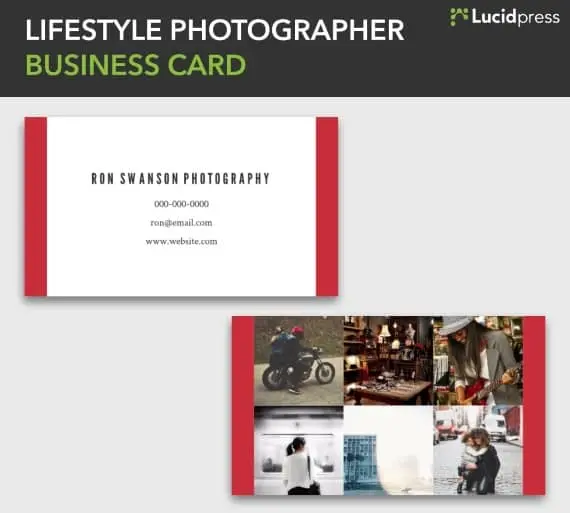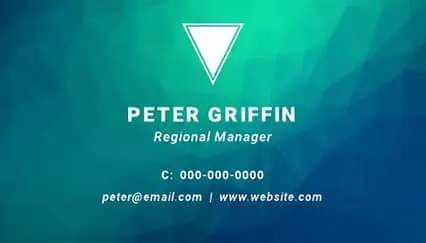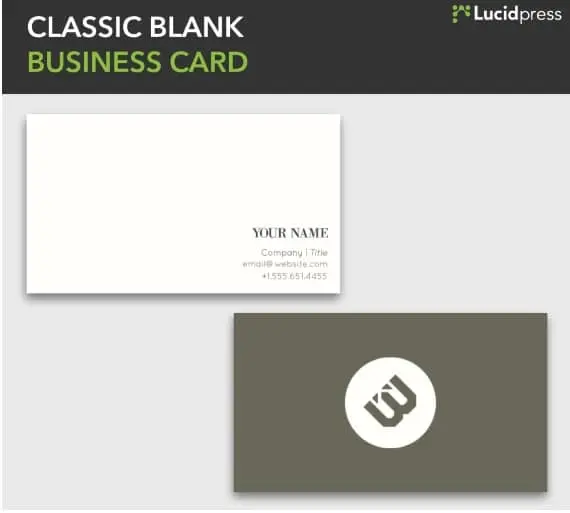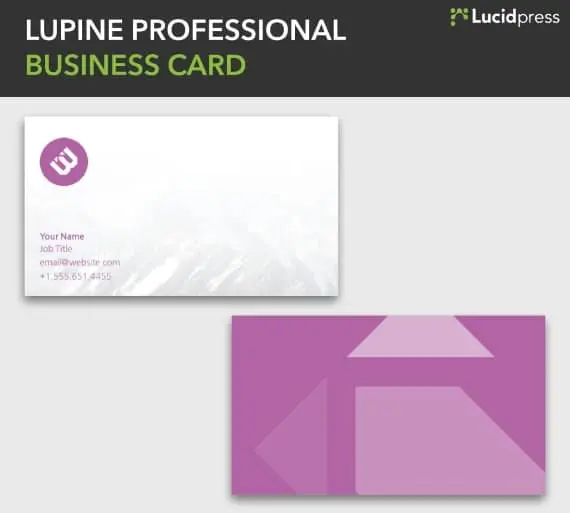Here’s a bummer statistic: 88% of people will throw away your business card within a week of receiving it. In fact, it is likely easier for them to just Google your name or business to find your contact info when they need you. But that’s okay, because exchanging business cards offers so much more than a way for people to contact you when they need your services.
Whether you’re at a job fair, trade show, or any other networking situation, your primary goal should be for people to remember you and your brand. With this higher goal in mind, here are 3 reasons why business cards still matter.
Related: 4 tips to prevent business card blunders
1. They help you create the right first impression.
In any networking situation, you typically get one shot to make a great impression.
“A business card can, if one chooses, provide more than just contact information through graphics, mottos, type face, or other visual content,” said Keith McHugh of Painted Rock Enterprises. “This additional content could elicit emotions or a message that helps you stand out from the crowd.”
2. They present your brand as trustworthy and credible.
Building new relationships with potential clients, vendors, or employers requires you to break through any walls that they might have built up. A polished business card is one way you can build up enough trust to break down those walls.
“Not having a card makes you look like a brand new, one-person company that works out of the home and can’t afford $25 for business cards,” says Perryn Olson, marketing director at My IT. “Prospective clients do not want to gamble with an unproven vendor.”
3. They’re still an effective direct marketing tool.
Here’s how the e-commerce platform Shopify defines direct marketing:
“…a promotional method that involves presenting information about your company, product, or service to your target customer without the use of an advertising middleman. It is a targeted form of marketing that presents information of potential interest to a consumer that has been determined to be a likely buyer.”
There is nothing more direct than giving a potential client a handshake and a business card.
In fact, Mark Aselstine, owner of Uncorked Ventures, describes a recent situation where his business card drove tangible revenue:
“I definitely go back and forth if they’re worth it, but I think they do help bring in sales, often in unexpected ways. As an example, I had a corporate client reorder a series of wine club memberships for holiday gifts this year, despite having the person who used to be responsible for the order leave the company. At first, I thought they had access to her email, but it turns out they found my business card in her desk after she left the company and looked up our history in their accounting software.
For me, there are times when I need to source a case or two of wine and I look through the stack of business cards to choose someone to buy something from.
In any case, as much as people want to talk about how antiquated business cards seem at times, they still do help drive sales, but often in unexpected ways!”
Ready to give your business cards a fresh look? Design your own for free right here in Lucidpress.
30 awesome business card examples to inspire you
Now that we know why it’s important to create a memorable business card, here are 30 creative business card ideas you can use for inspiration when creating business cards.
Creative business cards
Source: Lucidpress
Warm pastel creative business card
Source: Lucidpress
Bold impressions business card
Source: Lucidpress
Surf creative business card
Source: Lucidpress
Character creative business card

Source: Manriquez
Simple business cards
Source: Lucidpress
Source: Lucidpress
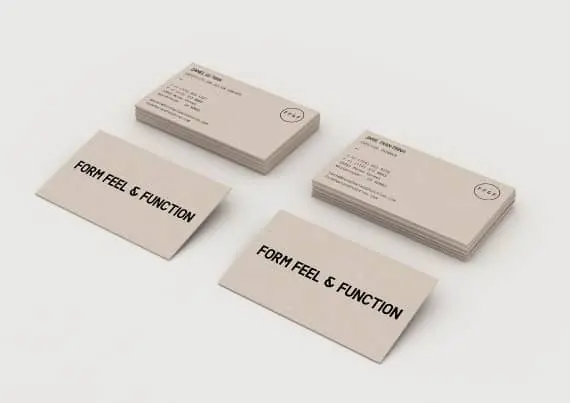
Source: Emanuele Cecini

Source: DK Design Studio

Source: Erica Boucher
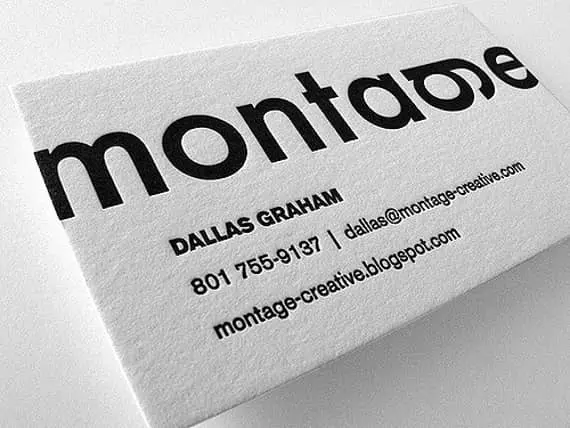
Source: The Mandate Press
Black business cards
Source: Lucidpress
Source: Lucidpress

Source: Nathan Riley

Source: Handsome
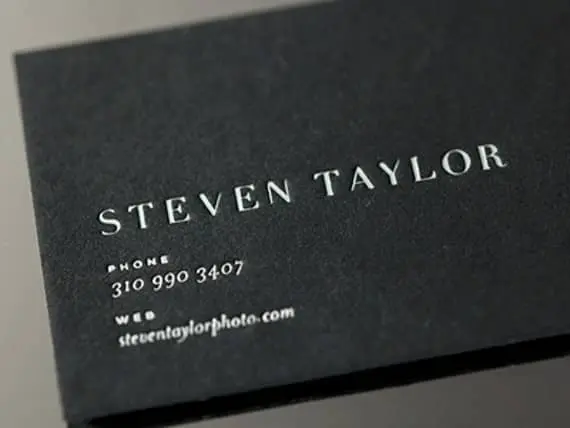
Source: Danny Jones
Double-sided business cards
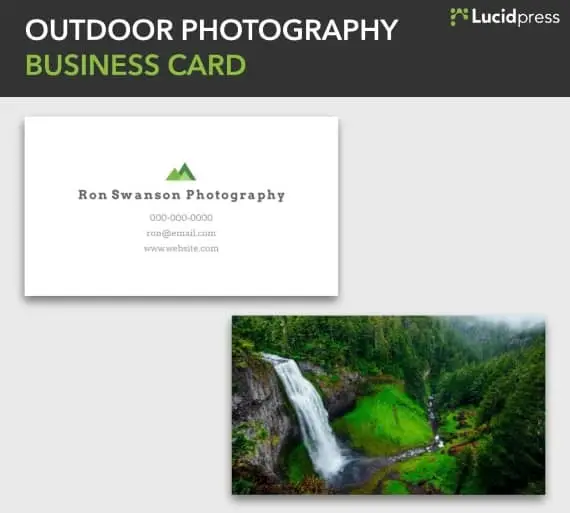
Source: Lucidpress
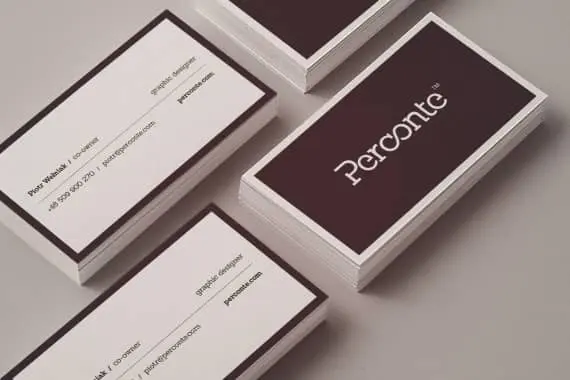
Source: Perconte

Source: Claudia Argueta
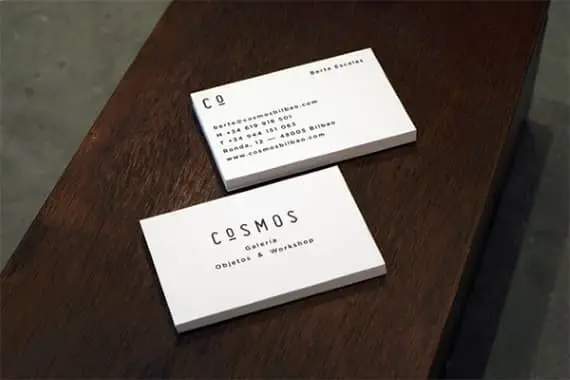
Source: Mark Brooks
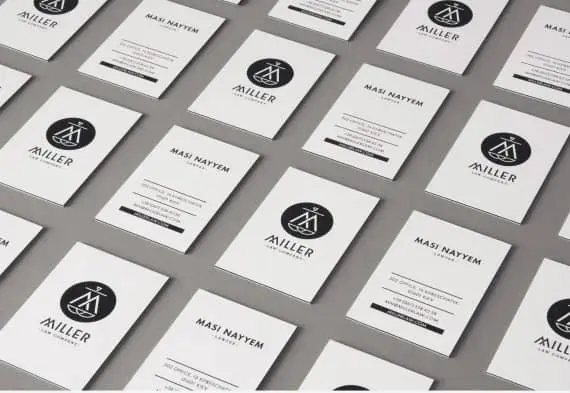
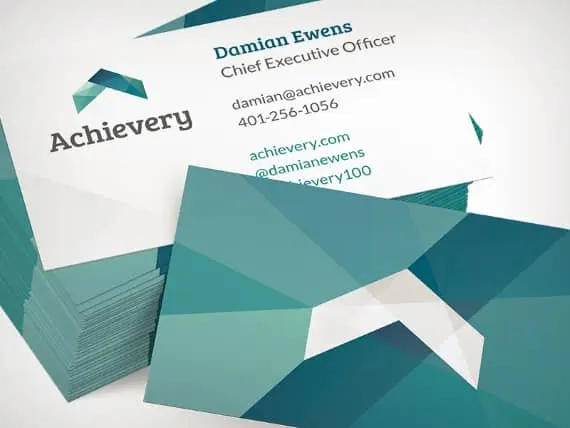
Source: Mike Camera
Vertical business cards
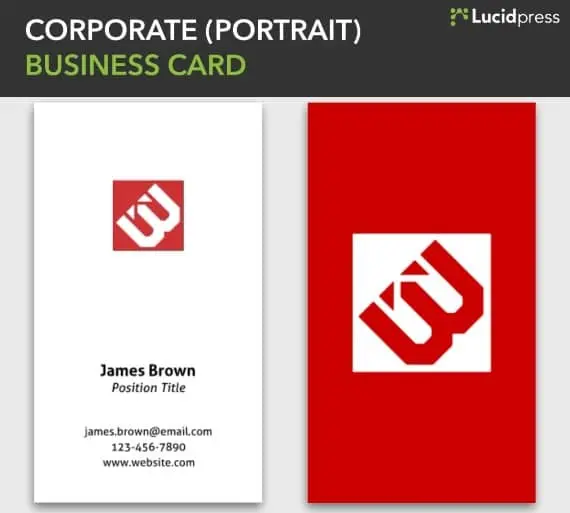
Source: Lucidpress
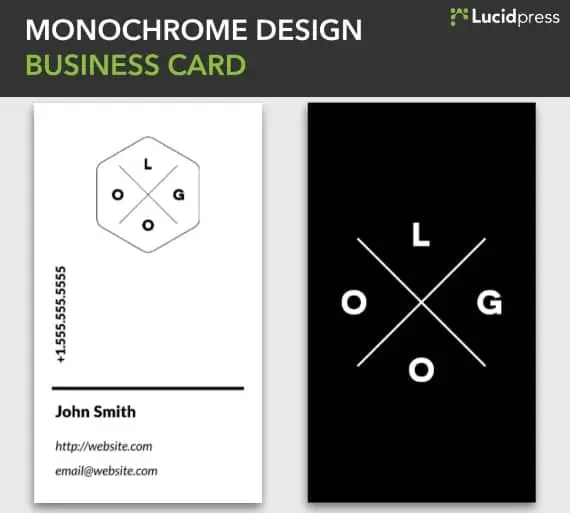
Source: Lucidpress
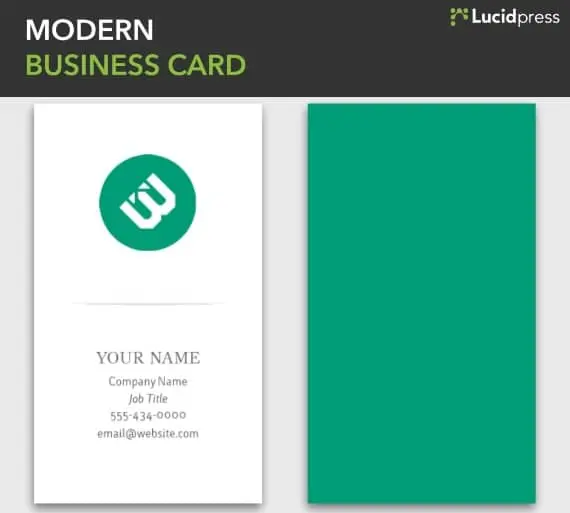
Source: Lucidpress
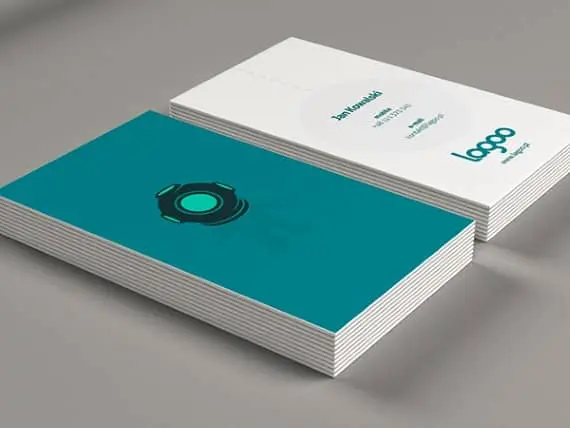
Source: Lagoo

Source: Janne Koivistoinen
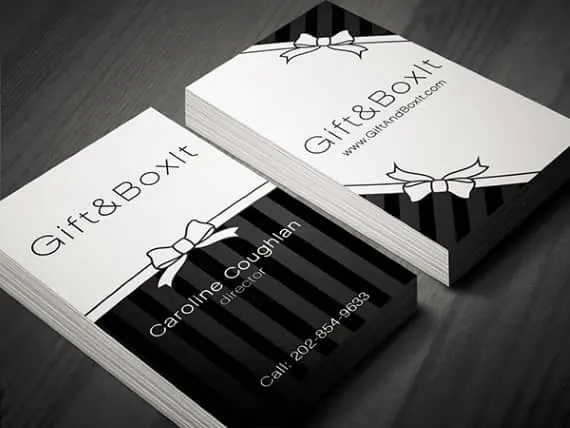
Source: Martina Obertová

Source: Giorgia Smiraglia
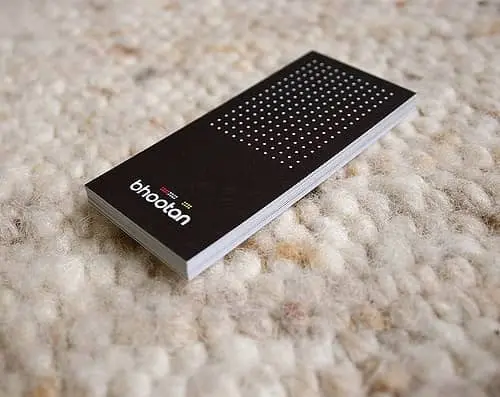
Source: Vik Design
Feeling inspired? You can design and order your brand new business cards right here in Lucidpress.
Here’s the thing: the in-person experience isn’t dead. And furthermore, direct mail marketing isn’t dead. It’s an audacious statement for sure. But like the in-person shopping experience, direct mail marketing is just different. It’s not the norm anymore. But that’s what makes it all the more unique and effective.
That said, there’s no doubting that online marketing has taken the world by storm. Not only is online video consumption reigning supreme over traditional TV viewership, but it seems the world has gone mad for — and forgot about — the value still held in offline marketing.
Direct mail marketing happens to be an excellent example of offline marketing. Think of direct mail marketing as you would letters, postcards and brochures landing right in the mailbox of your ideal customer. That’s pretty spiffy!
What is direct mail? Direct mail is a form of direct marketing where promotional materials are sent to prospective customers in the mail.
Related: Building a local brand—5 essential things to know
Your mailbox — you know, the metal one with your address on it — has a bad reputation. Meanwhile, your email delivers discount codes for your favorite shops and other exciting tidbits of information. But that IRL-mailbox space is filled with bills, junk mail, earwigs and who-knows-what-else, right?
Sometimes, but not always.
While you’re certainly bound to receive bills, junk mail and find the occasional earwig in your mailbox, you can also count on uncovering letters from family members or collateral that’s seemingly custom-fit for your needs. It’s almost as if those ads you’ve been seeing all over social media popped up in your mailbox, which is pretty cool, right? That’s what direct mail marketing has the capacity to do.
So, what can direct mail marketing offer that online marketing can’t?
Direct mail marketing gives customers a tactile, interactive experience that they (perhaps unknowingly) crave and miss when they get a coupon emailed to them or when they are bombarded with an ad on social media.
But direct mail marketing doesn’t stop there — it delivers three other noteworthy factors.
Direct mail marketing is easy to understand
One reason direct mail marketing is more effective is because it’s easier to understand. One study found it takes 21% less cognitive effort to process, meaning your audience (or prospective customer) don’t have to invest time or extra brainpower into your postcard, mailer or any other type of direct mail marketing campaign.
The success of any marketing campaign — whether it be direct mail marketing or an online campaign— is contingent on whether or not it resonates with your customers. Because, if your target audience is finding the content difficult to understand, or if they feel confused or lost at any point in the content journey (or hile reading the collateral), your campaign is unlikely to meet success objectives.
Direct mail marketing feels more memorable
Forgive us for being a tad melancholic, but, there’s something incredibly heartening about receiving a letter or a package in the mail. It feels very human — as if there’s another person on the other end of the care package or neatly tucked behind the envelope. Someone had to go to the effort to writing said letter or find knick knacks to stuff into a box. You remember mail — along with the person who sent it and why they sent it along.
Plus, studies show that millennials who spend more time with a physical ad in hand have a stronger emotional response to the marketing campaign, lending a stronger overall memory of the ad. Who knows, you could be on the list of the next generation’s most-loved advertising campaigns by optimizing your use of direct mail.
Direct mail marketing has stronger response rate
Direct mail has a better response rate than email marketing, with 4.4% of campaigns receiving a response when delivered through the mail, compared to just 0.12% online. []
For example, for content (in a campaign) that’s delivered to 1,000 people, 43 more people will interact with your direct mail than your emails.
As in, you’re missing out if you push your entire marketing budget into email — especially when direct mail can be more cost-effective.
The Do’s and Don’ts of direct mail marketing
Want to stand out from the crowd and make sure you pull off a marketing campaign that drives a high ROI? Here are three tips.
DO proof your stuff
Typos or misspelled names are a surefireway to undermine your authority or make a customer doubt what you have to bring to the table. Proofread your stuff before sending it out. And make sure you get the customer’s name right.
DO have fun — Get creative
Get creative with you direct mail marketing campaigns! Don’t just fire off a boring letter that could get mixed up with a prospective customer’s bills. You want to create something memorable — something that familiar or maybe even something nobody has seen before. Don’t be afraid to throw a proverbial party in their mailbox!
You can do this by sending:
- Foldable origami
- Customized postcard designs
- Interactive letters, where your audience needs to do something to reveal a message
A fantastic example of creative direct mail marketing comes from the team behind World Water Day’s campaign. Their aim was to raise awareness about the event, but they opted to create a direct mail with words that only became visible when soaked in water.
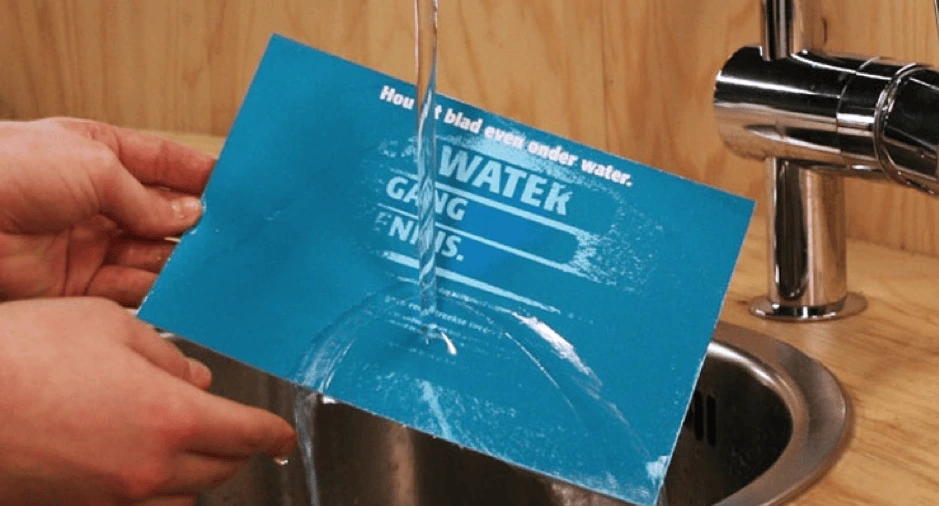
Not only did this direct mail campaign explain World Water Day’s campaign aim creatively, it also became an interactive piece of content. Interactive content has been proven to generate 2x more conversions than the alternative. That’s pretty genius, right?
Lucidpress: Click the image to use the template
Use one of our direct mail templates as inspiration for your own direct mail piece. Switch out colors, fonts and texts to create your direct mail postcard or flyer in seconds.
Browse all direct mail templates



DO emotionally engage customers
The second way to ensure your direct mail marketing campaign is a success is to make your audience feel something — any type of emotion. After all, there’s such a wide range of them. Emotion has been the marketer’s secret weapon for years. Various studies show that people rely on emotions, not just logical information or data, to make buying decisions.
Feelings of anger, disgust, affirmation and fear often top the list of emotions that work well in advertising.
A fantastic example of this comes from the Natural History Museum. In an attempt to educate local people about the danger of animal extinction, they sent an eraser to their audience with a quote about the topic.

Because their audience could see a visual representation of extinction in their daily lives, it made them stop to think about how serious it is… and want to act.
Pick an emotion and drive it home through your next direct mail campaign. You’ll soon see the impact emotion has on marketing—but the victories will be for your own brand.
DO put your own spin on it
For the most part, mailboxes aren’t fun environments. Bills, bank statements and lonely newspapers often clog up the mailbox marketing route. But, you can stand out by making your direct mail marketing campaign a little unique.
A fantastic way to achieve a little uniqueness is through juxtaposition. Can you think of a smart, innovative way to show how powerful your offering is by comparing it to something completely different?
Let’s take this direct mail campaign for example. Created by the theatre team behind a local performance of Macbeth, they wanted people to visit their show. Instead of online marketing, they exploited their direct mail opportunity and found a way to stand out in a mailbox.
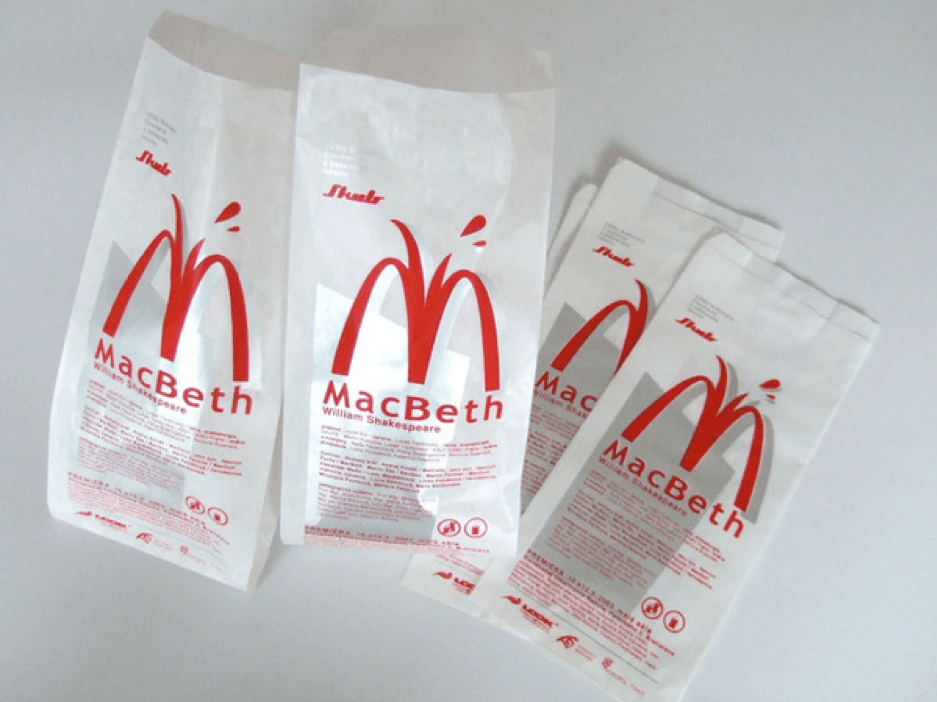
You’d probably never compare a Shakespeare play to a fast food joint, right? But that’s part of the reason why it works.
The juxtaposition of both elements makes you take a second take at the direct mail rather than toss it in the trash. This type of content experience (within direct mail marketing) is bound to make an impact on an audience, one who possibly has an interest in both but would never expect them to be paired together.
All in all, direct marketing provides you or your creative team with untold opportunities to lean into the creative, get weird and try new things. Plus direct mail marketing allows you to access new customers or get a feel for a prospective audience who might otherwise pass up your product or services.
DON’T skip doing the proverbial “leg day”
Leg day for direct mailing entails defining your audience and running some tests before you send out the direct mailers. Now, neither task needs to be a heavy lift. Defining your audience can be as simple as knowing who your product is best suited for and tailoring where and what neighborhoods you send the direct mail to based on this information.
Additionally, try sending a few flyers or direct mailers out to a small segment of your target audience. Make sure to include trackable tests, like a QR code or a custom URL (which we’ll touch on more momentarily).
DON’T forget to set goals for the campaign
Consider the following questions. As in, are you looking to drive brand awareness or boost sales of a particular product? Are you looking to assess brand awareness, and if so, how will you measure success or failture? Alternatively, if you want to increase sales, what is the target revenue or fiscal marker for your campaign? Specific goals will give you a benchmark to measure (and brag about) the campaign’s success, and it will help you drive improvement based on the results.
DON’T ignore the importance of a CTA
Simply put: You need a way to measure your goals and attribute which-sales-to-what-campaign-directive. Well, a CTA can help with that. Start by creating a custom URL to include in your direct mailer. This custom URL will empower you to track visits and sales from the website location, allowing you to attribute conversion and ROI to your direct mail campaign.
DON’T spam your customers
Inundating your customers with a lot of direct mail, emails and more is not the best way to get their attention. Sure, you’ll be top of mind, but it’ll be because you’re irritating them — not inspiring them or addressing a pain point. You don’t want to undermine the relationship you’ve worked so hard to build with them, so be mindful of who-you-send-what-where-and-when.
You’ve got mail — Lucidpress mail
If you couldn’t tell already, we’re big fans of direct mail. Now, the exciting part about Lucidpress is that we don’t just empower anyone to create compelling, effective content — we also make it easy to conduct a direct mail marketing campaign.
Choose from any of our direct mail marketing templates to customize and edit. Or, alternatively, if you’re feeling brave, you have the option to design your own. Then, all you’ll need to do is:
- Upload a .CSV file containing the details of people you’d like to target,
- OR use radial search to select a local delivery area.
Once selected, press the proverbial “go” button and use the direct mail marketing integration to send your mail directly within a matter of days. There’s no need to stop at your local post office with oodles of mail, thus, taking the stress out of building a direct mail marketing campaign.
As you can see, direct mail isn’t an old-school marketing technique that should’ve stayed in the 00’s. These tips, along with our new features, could be the combination you need to build a direct marketing campaign that drives excellent results for your business.
Learn more about the direct mail features in Lucidpress, and give it a test drive.
Bonus: Direct mail infographic
Craving more data? Check out this illustrative infographic about direct mail from our friends at Colourfast.

When you run your own business, you’re responsible for a lot. Aside from keeping the business running smoothly, you’re responsible for producing your product or service, hiring employees, marketing and managing your brand, and doing anything else your business requires.
Related: Direct mail marketing: Does it still work?
Today, let’s focus on the marketing aspect of your business.
In this article, we’ll focus on one type of direct marketing known as direct mail. Specifically, we’ll offer 10 suggestions for how to implement direct mail in innovative and creative ways. To start, let’s take a look at exactly what direct marketing and direct mail is.
What are direct marketing and direct mail?
Direct marketing is an assertive form of promotion in which a company reaches out directly to its target market. The point of these campaigns is to connect with consumers on an individual level, showing that they’re important to the company.
One example of this is telemarketer calls. Some other types of direct marketing:
- Email marketing
- Direct mail marketing
- Direct-response advertising
- Face-to-face selling
- Text marketing
- Distributed leaflets & flyers
Our focus today is direct mail—where advertising content is sent directly to a target market’s mailbox. The content could include letters, postcards, flyers, or anything mailed directly to a home or place of business.
Is direct mail still effective?
When you use direct mail correctly, it can be an extremely helpful tool in your advertising toolbox. You can “speak” directly to your audience and give them detailed information about your brand. In addition, you can easily track the success of a campaign.
However, you must practice care when you’re conducting these campaigns.
If you do this incorrectly, consumers will view the content as “junk mail.” Avoid this by providing consumers with content that is timely, relevant and important to them. You can also provide useful tools—for example, a coupon or promo code for your services.
How to use direct mail creatively
Now that we know what direct mail is and the benefits it can bring you, let’s brainstorm a few ways to use it for your brand. Below, we’ve gathered 10 innovative ways that you can use direct mail for your business.
1. Deliver discounts
One common-sense choice for direct mail marketing is to send out info about discounts and specials. This could mean one of two things. First, you could send out direct mail when you have a sale coming up.
Second, you could send out coupons for your service that are exclusive to your direct mail campaign. This is a good way to measure response and ROI, because you’ll know whenever a customer redeems the discount.
2. Send out samples
In addition to sending out discounts, you can send out samples to your customers. Of course, you should only do this if you have ample budget for the expense. It’s probably not the best tactic to use for your first campaign, but after you’ve gotten a handle on typical response rates.
If you can swing it, samples are a great way to attract new customers who don’t want to pay money to try out your product. In addition, if you have new products, samples are a great way to introduce current customers to your new products.
3. Offer reminders
Reminders are a cheap way to stay top-of-mind. You can send out reminders for upcoming events—for example, a realtor could announce an open house. You could also call attention to grand openings, deadlines or appointments. An example you’re probably already familiar with is receiving a letter from your doctor or dentist about your yearly check-up.
4. Share announcements
You can also use direct mail to deliver company announcements. This keeps your customers up-to-date on new developments such as different hours, new contact info, new products and more.
5. Use QR codes
QR (quick response) codes are a great way to connect your mail campaigns to your digital marketing efforts. They’re simple barcodes that are easy to print on a piece of mail and can be scanned by any smartphone.
One scan, and a QR code can be customized to take your customer anywhere you need. For example, you could design a QR code to take your customers to a specific landing page. Most people are familiar with QR codes these days, so their presence on your mail will be self-explanatory and easy to follow.
6. Add texture
When someone goes through their mail, the last thing you want is for yours to be immediately disregarded or tossed away as junk. One way to combat this is to make your mail more eye-catching than the rest.
There are a few ways to do this, but one of the easiest is to add some texture to your mail. For example, you can use embossed lettering to make it stand out when a customer grabs a handful of letters and newspapers.
7. Pop with 3D mailers
Using texture is a subtle way of differentiating your mail, but there is a more obvious way to set your mail apart. You can send out 3D mailers, such as a box or tube or any other 3D design. These will jump out to customers and spike their curiosity, prompting them to open your mail and take a look rather than just throwing it away.
8. Track personalized URLs
One way to track how well your direct mail is working is to use personalized URLs (PURLs). Like QR codes, they’re a digital extension of your message. PURLs will lead your customers to your website in a way that leaves a trackable footprint. You’ll easily be able to see how many of your customers responded to your direct mail campaign by checking the page’s stats.
9. Try augmented reality
When people think of augmented reality today, they think about games like Pokémon GO. However, augmented reality does have a place outside of entertainment. In fact, you can incorporate the idea of augmented reality into your direct mailing.
Usually, this is done through the use of an app. For example, in 2015, Toys R Us used augmented reality techniques to create a game out of a piece of their direct mail.
10. Wow with video in-print
Finally, there are video in-print techniques. This is a cool idea because it eliminates the middlemen (apps, websites, etc.) by including a video player directly in the mail. Right now, these are a bit pricey—but keep an eye on them for the future.
Key takeaway
When executed creatively, direct mail marketing can provide a huge boost to your promotions and brand awareness. Whether your goal is to be top-of-mind or to drive bottom-funnel sales, you can build a direct marketing campaign to match. By crafting professionally designed mailers, you’ll attract your target audience and reinforce loyalty among your customers.
Learn more about the new direct mail features in Lucidpress, and give it a test drive.
Direct marketing can be extremely effective for businesses focused on serving specific geographic areas. By sending letters, flyers, and other marketing materials straight to prospects’ homes or workplaces, you can generate business in a cost-effective manner.
Related: Direct mail: Does it still work?
Direct marketing (also known as direct response) is an umbrella term that includes email, online display ads, paid search, and direct mail. The common denominators are 1) they target specific people and 2) they ask for some type of action.
The requested action could be anything from giving you a call or redeeming a coupon to scheduling a free consultation or starting a trial membership. The possibilities are limited only by the marketer’s imagination.
In this post, we’ll focus mostly on the time-tested technique of direct mail, which remains very profitable for realtors, gym owners, franchisees, and other businesses focused on serving local communities.
How can you measure your performance?
Let’s discuss the key metrics of direct marketing campaigns. Understanding these is the first step to ensuring that your strategies are always improving.
Direct mail open rate
When most people get their mail for the day, the first thing they do is separate the “junk” pile from the stuff that deserves their attention. Getting our messages into the stuff-to-open pile is the first hurdle direct mailers must clear.
How often does this happen?
Unfortunately, because we aren’t in prospects’ homes or offices with them, this is a difficult metric to track. Paper mail is a different animal than an email campaign, for instance, because email marketing software allows us to track how often our messages are opened and clicked.
It’s unlikely you’ll know what your direct mail open rate is. That said, prospects can’t respond to a message they haven’t read, so we want to do everything we can to increase it. That’s why seasoned marketers test different variations of the same direct mail package. Seemingly subtle details—like the envelope color or the font of your prospect’s address—can make a significant impact.
By sending out two versions of the same marketing message (a process called A/B testing), you can track which version performs best. After enough testing, the winning version becomes the “control,” which you can test against newer variations. This ensures that you’re constantly optimizing your direct mail packages to get opened as much as possible.
Let’s say you’re a realtor looking to build your client base in a new neighborhood. You decide to send out 500 letters introducing yourself and asking for interested recipients to give you a call. Your message is the same in every letter, but the envelopes are different. 250 are white. The other 250 are yellow.
You get 13 calls from the white group, but only 6 from the yellow: a statistically significant result. We don’t know for sure how many people opened the envelopes, but because the response was so much higher with the white group, we can assume it’s the better option moving forward. Next campaign you might test it against another color, like light blue.
Direct mail response rate
The response rate measures how many prospects follow up after seeing your messages.
A response isn’t necessarily the same thing as a sale. It often will be if you’re selling inexpensive impulse items, like a pizza store owner mailing out coupons. In those cases, responding (using the coupon) is the same thing as becoming a customer. But that isn’t always the case with more expensive products (like real estate), when people might respond before they’re ready to buy.
How do you measure this?
The challenge becomes figuring out which prospects responded due to your direct mail as opposed to other marketing channels. Here are just a few strategies you could use to track response rates:
- Call tracking. Assign unique phone numbers to specific direct mail campaigns, so when prospects follow up you can see where they came from.
- Coupon or discount codes. You’ve probably seen these in your own mailbox. Local businesses often create special coupons for direct mail campaigns. When prospects redeem them, it’s easy for the business owner to track their success.
- Exclusive offers. You could create special offers exclusive for direct mail recipients, so you know they couldn’t have discovered them anywhere else.
- Personalized URLs. A tech-savvy way to track responses is to have direct mail recipients follow links to unique landing pages you’ve created for the campaign.
- Just ask. Businesses often ask new customers how they heard about them, collecting responses via informal surveys.
Don’t worry if your response rate seems low. In 2017, the Data & Marketing Association’s Response Rate Report found that the average response rates sent to houses was about 5.1%. The same report revealed that oversized envelopes had the highest response rates, probably because they stand out from the pile.
Imagine you own a hamburger restaurant. You decide to send out coupons to promote your new curly fries. You send out 2,500 coupons, and 175 people end up redeeming them. What’s your response rate?
The formula is simple. All you have to do is divide the responses by the total pieces sent. In our burger example that turns out to be 7%—a great response!
ROI
Direct marketing can be extremely profitable, but there are certainly still costs involved. Everything from accessing mailing lists and databases to printing services, postage and the paper itself—these things add up.
Your marketing budget is limited. Tracking your results will ensure you’re allocating every penny where it’s most effective.
That’s where ROI comes in. This acronym, which stands for “return on investment,” assesses the revenue your campaign brings in relative to its cost. It’s probably the most important metric to pay attention to because you can compare it with the results from other marketing efforts.
Say you’re a gym owner offering a great deal for a new membership. You spend $6,000 on your direct mail campaign, which results in $7,800 of new business. You want to know your ROI.
The formula to calculate ROI is as follows: (revenue – campaign cost) / campaign cost. So, in our example, we get (7800 – 6000) / 6000, a very respectable 30%.
Your turn
Although many small business owners are overlooking direct marketing in 2019, it remains a viable strategy for businesses targeting local areas. You might use email, direct mail, pay-per-click, or all of the above.
Understanding the key metrics will help you see how well your campaigns are paying off. Continuing to track them while you experiment with messaging will ensure they’re as profitable as possible.
Learn more about the direct mail marketing service in Lucidpress, and give it a test drive.
Direct mail is not dead or in a cryogenic freeze. It has not joined the video cassette or the typewriter as an obsolete relic. Even here in the digital age, implementing a traditional direct mail campaign can still be a highly effective tool in your brand’s marketing toolbox.
Related: Direct mail marketing: Does it still work?
Engaging customers through multiple platforms & channels is the ticket for boosting your response rate. Direct mail is a path to success when it’s personalized to your target audience and driven by a well-executed direct marketing strategy.
So, what can set your direct mail campaign apart? Here are 5 effective practices you can implement to attract customers’ eyes (and dollars) to your business.
Personalize your content
Everyone wants to feel special. Taking an individualized approach with direct mail can create that feeling for customers and potential customers alike. Rather than seeing your mail as junk, they’ll feel like you really know them and understand their needs.
It starts with using a recipient’s name, but it doesn’t end there. Find a way to connect by personalizing the product or service you offer. This can be as simple as adding the address and operating hours for your organization’s nearest location. It could also involve tailoring a specific offer toward products that will be most relevant to them based on observable data.
When you break your target audience into narrower niches, then tailor a personalized offer for each person, it will supercharge your marketing efforts. Your content will have a better chance of resonating with your audience and generating sales down the road.
Add more information
A flyer, brochure or insert can feel more permanent than a tweet or an email. Your audience can see it, handle it and read it. A customer is likely to spend more time with a piece of direct mail than with an email or tweet. It opens the door to provide more information.
Include all the information you need to get customers to make the decision you want. There are a few ways to accomplish this goal:
- Use clear, attractive images that draw the eye.
- Incorporate graphics & text that mesh with your brand and convey the right message about your products or services.
- Include authentic testimonials that show a customer why they should choose you over a competitor.
The most important thing is to keep your focus squarely on the customer’s needs. You want to earn their loyalty, and your direct mail content should aid in reaching that goal. Concentrate your message on how your brand benefits the customer in terms of value, convenience and quality.
Make your call-to-action count
The goal of direct mail is the same as any other marketing channel. You want to convince a customer that doing business with you will improve their life. That’s where a well-designed call-to-action is so essential. It’s the glue that holds everything together.
A call-to-action should be compelling enough to spur a customer to take action. You should make it clear, concise and powerful. Keep it in front of them by including the call-to-action multiple times throughout the piece. In this case, don’t look at the repetition as being annoying. It actually helps a customer remember your offer long after they read the mail.
So, where should you include it? Use sidebars and a postscript that are offset from the main body of content to deliver a repeated call-to-action. Incorporate a consistent voice that ties back into your core brand messaging.
Keep data fresh
Timing is everything with an effective direct mail campaign. You have to send it to the right people in the right places at the right times to get the maximum return on your investment. The best way to put the odds in your favor is to keep your database relevant and up-to-date.
Accurate data helps you correctly identify your target audience and their interests. It also helps you avoid missteps on building out mailing lists. If a lawn care company distributes mailers to the residents of an apartment complex, for example, it’s likely to be a wasted effort because few of those people will need their services. Keeping data up-to-date would help such a company locate neighborhoods filled with homeowners who would love to use their services.
Having correct data will help you understand which stages of life your customers are in and how to best meet their needs. Marketing is most effective when you can offer evidence that your brand fills an identifiable need for your target audience. It sticks with them and keeps your business fresh on their mind.
Integrate with other marketing
Your direct mail strategy should not be stranded on a deserted island among the palm trees and coconuts. Integrate this strategy with your other marketing efforts, so that it’s a part of the same marketing plan. This also means sticking with it once you get started.
Persistence pays off in all forms of marketing. One-and-done approaches won’t work, because you can’t cast a wide enough net to pick up every potential customer. Be prepared to send out multiple mailers to your target audience. Utilize A/B testing to see which content strategies work best, so you can optimize your efforts. It typically takes multiple contacts before direct mail finally spurs a call-to-action.
Align your direct mail campaign with your emails, online ads and social media promotions. Use the same images, graphics, coupon codes and other materials in those digital efforts. It builds synergy and keeps the customers going in the right direction, no matter where, when and how they made initial contact with your brand.
Learn more about the direct mail marketing service in Lucidpress, and give it a test drive.
It’s getting harder to put your marketing messages in front of consumers. Increased digital competition, changing algorithms, and a crowded social media space mean you have to work hard to stand out.
So how are marketers breaking through the clutter? By revitalizing some tried-and-true, pre-digital strategies like direct mail.
Related: Direct mail marketing: Does it still work?
Receiving something in the mail is sure to get people’s attention. These 11 direct mail examples will inspire you to launch your own effective direct mail campaign. We’ve chosen each one because it showcases a particular strategy you can use to generated direct mail ideas for your own marketing pieces.
Bold text

Your central marketing message should be the first thing a recipient sees when they receive your direct mail piece. The Waterfront open house postcard has big, bold text taking up almost half of the design, so the main marketing message gets across right away.
If you design your own piece with bold text, just remember not to go overboard—you can overdo it. Balance the text with complementary images, and leave some space for the design to breathe.
Shaped text

Another great way to get people’s attention is with interesting shapes. This office party invitation from Every Door Direct Mail organizes text into a Christmas tree shape, a surefire hit around the holidays. You can organize text into all sorts of shapes, from beer bottles to flowers. It’s a fun and creative way to add some eye-catching visual interest to your direct mail piece.
Stunning images

While your marketing pitch lives in the text, great images capture attention and evoke emotion. This Parisienne travel postcard gets viewers thinking about travel and romance with a pretty, black-and-white photograph of the Eiffel Tower. It’s good practice to choose an image that complements your brand and your offer, but the primary goal is to make a strong emotional connection.
Macro photography
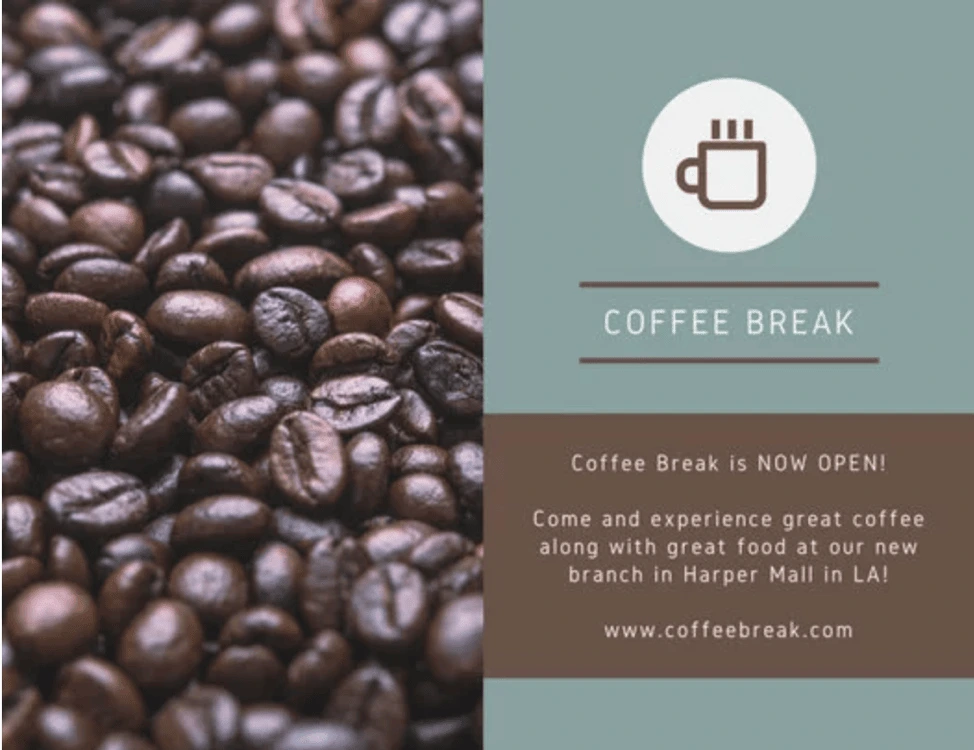
Direct mail pieces have to stand out from the stack of mail that people receive every day. Macro photography is a great way to provide a new perspective on a familiar object—and this direct mail piece from Canva puts this strategy to good use. Rather than a standard cup of coffee, this alluring photo evokes the scent, taste and tactile feel of coffee beans.
Of course, you don’t have to use coffee beans—or any food, for that matter. If there’s an object that represents your brand, product or service, use macro shots to highlight it. If you can use an image that’s personalized to your customers or local area, even better.
Eye-catching colors
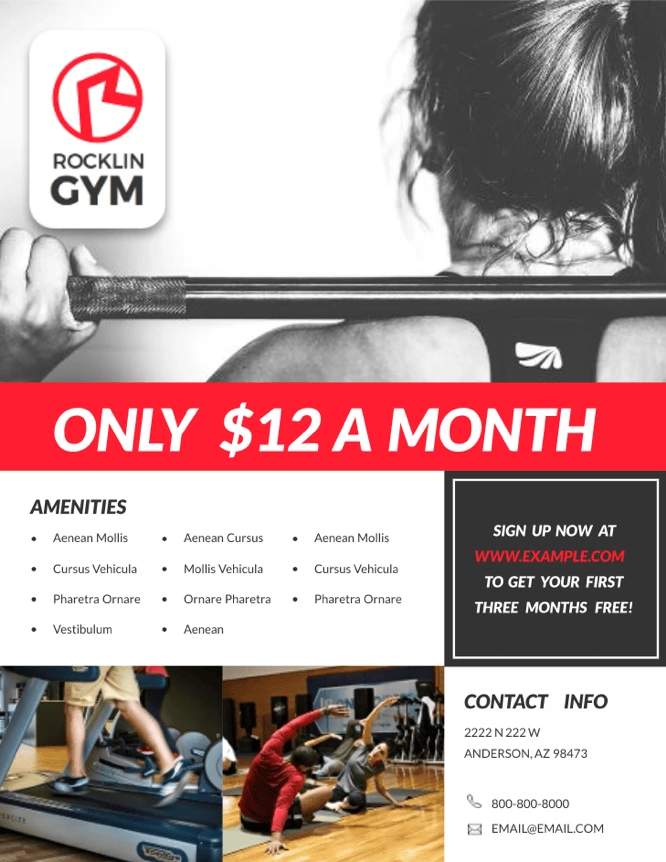
When you look in your mailbox on an average day, what do you see? Probably a sea of white (and off-white) envelopes, most of which look the same. The bright red stripe on this gym fitness flyer immediately stands out and draws attention to the value proposition. Be prudent with your color pops—an overly bright direct mail piece can look tacky and overwhelming. Stick with tasteful highlights like those showcased in this design.
Different shapes

Mailboxes are crammed full of standard envelopes and flyers every day. If your advertising needs to stand out, why not try a different shape? This modern tri-fold brochure will grab people’s attention not only with its color-blocked design, but also with an unusual shape. Folded pieces have a three-dimensional aspect to them, making it more likely to get noticed.
A personalized map

Personalization is a standard digital marketing tactic, but it’s more difficult to achieve in the direct mail space. Maps4Mail solved that by printing customized maps on each piece of mail, showing the recipient exactly where they need to go. The map is intuitive, personalized, and makes it easy for anyone to find your business. This is a great way to show customers you personally value their business as individuals.
If you don’t have the budget for such a granular campaign, you can still try other ways to add a personal touch to your direct mail. For example, you could include something specific to the local area, or you could include your signature.
Unusual materials

Most letters and flyers are printed on the same white paper. That’s not very exciting. If you can find materials or textures that stand out, you’ll have a big advantage over the competition. Heavy or textured paper work nicely, but if you really want to branch out, check this: These postcards from Cards of Wood are (as you would guess) made entirely of wood. Wood you believe it?
3D objects

People are curious creatures, and we’re more likely to open packages that contain objects. If you can get your brand message across with an object, it can serve as a fantastic ad. Amnesty International sent out these pencil chopsticks to encourage people to write to the Chinese government. Thinking outside the box (or should we say inside) can get great results in direct mail because people spend more time with it.
Interactive mailers

Not every brand can afford to design interactive mail pieces—but if you can, there might be no better way to connect with your customer. This piece from BMW had customers cutting a path through a wintery postcard to emphasize the reliability and control of their snow tires. Their combination of an envelope and mailer is great creative thinking.
Gifts
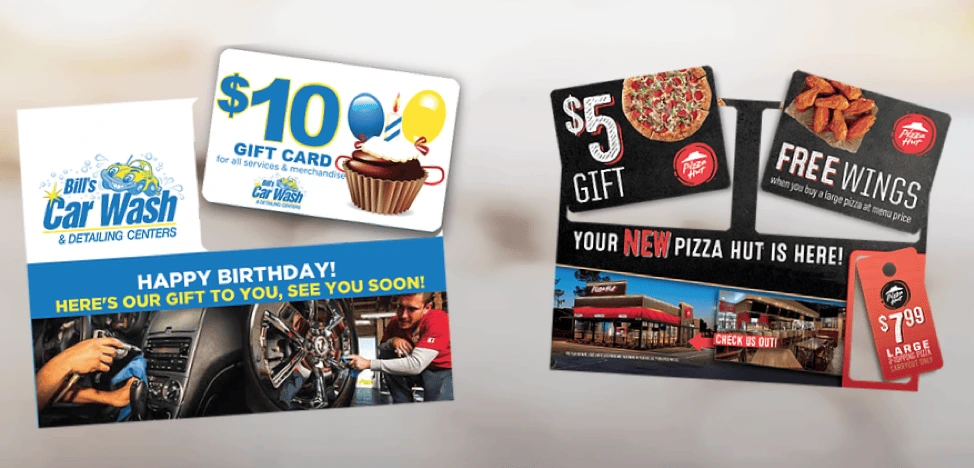
Many direct mail pieces focus on the value brands can provide to their customers—but you’ll have to go further if you want to stand out. A coupon is a good start, but that’s still fairly common. Consider including a punch-out gift card instead. It lets you take advantage of an unusual material (plastic) and give the recipient a gift. A great combination that’s tough to beat.
Key takeaway
People get a lot of mail they didn’t ask for, and different brands will find success with different types of direct mail. The most important thing is to stand out and provide real value to your audience. These examples should get your creative juices flowing and inspire the best direct mail campaign for your own marketing goals.
Ready to create your own direct mail designs in minutes? Check out our direct mail postcard templates.
The rapid rise of digital media—and the simultaneous decline of print media—has been glaringly obvious. Given the clear success of online methods like social media marketing, pay-per-click advertising, and search engine optimization, it’s not surprising to learn that many businesses are increasing digital spends.
Related: Why print will never die—Print vs. digital collateral
In terms of boosting brand awareness, digital is an obvious choice for many marketers. After all, more than three-quarters of Americans shop online. With digital, you can see which content is viewed most, where visitors spend their time, and when conversions have taken place…
…all benefits that we simply don’t see with print advertising.
Yet an important question remains: Is digital everything? Is digital enough to build brand awareness? There are subtle hints in recent studies that point to a surprising conclusion. Rather than going all-in on one or the other, your brand awareness might benefit most from a dual-approach. Let’s set the scene.
Is print media dead?
Remember how excited Amazon was when it launched the Kindle? Well, overall, eBook readers haven’t been anywhere near as successful as initially thought. In fact, eBook reader sales are in decline as readers prefer the look, smell and feel of a real book. The importance of tactile experiences in awareness & engagement is a factor we can’t overlook.
Print media and digital can’t always be described as standalone entities. Consider where digital would be without print. Alive? Sure. Alive and kicking? Probably not. There’s a lot of overlap between the two—QR codes, for example—which leads many to wonder whether a significant portion of digital’s success can be traced right back to print.
Ultimately, it seems that printing services are not as dead as they first appeared. Reports suggest that, while 88% of audiences will view a print ad for 2.8 seconds, only 4% of digital ads are viewed longer than 2 seconds. 35% of digital ads receive no views at all, a wasted opportunity that might be reclaimed with print ads.
Why use print to boost brand awareness?
Well, it comes down to how the brain works. Believe it or not, the brain seems to have a natural preference for printed materials.
Here are three scientific studies that show how effective print can be in boosting brand awareness.
Study #1: The emotional connection
Branding agency Millward Brown found that nothing compares to the emotional connection formed through print media. The agency claims that print leaves a much deeper footprint in the mind due to that personal, emotional bond. The study found that the parietal parts of the brain—responsible for absorbing and storing visual information—were more active in response to print ads than digital ones.
Study #2: Ease & simplicity
Neuromarketing firm True Impact has found that the average person uses 21% more cognitive effort to process digital information than print, suggesting that print materials are quite literally easier to absorb. The report backs its findings by demonstrating that 75% of those exposed to a print ad can successfully recall the brand at a later date, compared to just 44% of people who would could recall the same information after a digital ad.
Study 3: Out-performing across the board
In a study of direct mail conducted on behalf of the U.S. Postal Service, print media was found to out-perform digital materials in nearly every area. Print was the clear winner in terms of review time, stimulation, memory, speed, confidence, desirability and valuation. The only area in which digital performed better was gaining initial audience attention. Print materials can be tailored—personalized direct mail, for example—to combat this issue and come out on top.
Print vs. digital: Which is best?
Digital media has some clear advantages over print media. But looking at the research, it’s obvious that print still has a firm place in the marketing world. That’s why a number of businesses now focus on cross-media advertising, combining both print & digital to effectively and efficiently raise brand awareness.
By combining both methods, brands are able to target a much wider audience. Consider that, while 58% of newspaper subscribers prefer print, 28% say they are digital-oriented. There’s definitely a number of audiences who prefer print, so modern brands should reach out to these audiences, rather than isolate them.
Perhaps the best way to use both print & digital is to consider the unique advantages of both. Through multiple channels, you can reach multiple audiences and deliver your brand’s story. Consider reaching audiences with impressive print media, then create a more personalized experience through real-time, interactive digital media.
Ready to design your own cross-media campaigns? Lucidpress makes it easy to create beautifully branded content in a matter of minutes.
Marketing is getting tougher and tougher—there’s no doubting that.
With 41% of brands planning to significantly increase their marketing budgets this year, and customers becoming choosier than ever, you wouldn’t be alone if you’re exploring new techniques to get more out of your marketing cash.
Related: The complete real estate marketing guide
One strategy you should consider is SMS marketing, the process of sending short text messages to your ideal customers in an attempt to engage them with your campaign and get them to convert.
Even though average open rates for SMS messages beat email by a whopping 28%, your real estate company sells homes for a large price—unlike small-ticket items that can be purchased on a lunch break.
So, how can you make text message marketing your biggest driver of website traffic, leads and sales?
Here are the five steps you’ll need to build out your mobile real estate marketing strategy, as well as two brands who are already killing it with their text messages.
1. Determine who you want to contact
Just like any marketing strategy, you’ll need to base your mobile marketing campaign on buyer personas—a clearly defined document that lists details about your ideal customer.
For real estate companies selling student accommodation, that might include:
- People with less than $20,000 to spend
- Between the ages of 18 and 25
- No long-term commitments
- Currently living within 5 miles of the local college
Once you’ve got this to a T, you’re left with a bunch of shared interests. Use this information to find the people you want to target with your text messages.
2. Collect their information
The next step in your real estate text message marketing strategy is to collect the information of the people you’re targeting. You can do this by taking advantage of your other marketing strategies.
For example: why not run a Facebook ad, using the details you defined in your buyer persona, to encourage them to fill in a form? (You might need to offer an incentive to do this, such as a free ebook or a guide to purchasing a new home.)
But once you’ve got their information, don’t push the Send button just yet. You’ll need to have explicit permission from your prospect before sending an email, or you could land a hefty fine—and an unhappy buyer.
3. Choose an SMS marketing platform
While purchasing a new phone to send out your new messages is a great way to get started, it’s wise to invest in an SMS marketing platform from the outset.
That way, you can:
- Track various metrics after you send, including open and response rates
- Send SMS messages in bulk
- Personalize each message you’re sending
- View your strategy online, and share with other staff on your marketing team
Platforms like Text Local, Text Request and Textedly can help with this, just to name a few.
4. Select a text messaging schedule
Gotten to grips with your new software? Awesome! It’s time to make a start on your text messaging schedule.
You’ll want to put some thought into the time of day you’re messaging your potential buyers, and the day of the week they’re being delivered.
Why? Well, because texting your customer at 11pm could frustrate them—they’re likely to be asleep. However, sending an SMS message at 5pm could reach your customer when they’re on their daily commute with time to respond.
Find the perfect schedule by referring back to your buyer personas and filling out a daily routine for them.
Remember: You want to push your messages at times they’re unlikely to be busy—and have time to invest into their search for a new home.
5. Perfect your messages
Before rushing off and sending the first message that comes to your head, take some time to think about what you’re actually sending. You don’t want to send 10 messages only to find a spelling mistake, right?
Use key copywriting principles to make your sales messages as effective as possible, and focus on replicating your ideal customer’s language.
Going back to our example of student accommodation, this example:
“Ready to let your hair down at this years’ Homecoming? Make sure you’ve got somewhere safe to call home. Reply PARTY to find five local student dorms near Stamford from just $200/month.”
…would be much better than:
“With stunning high ceilings and low-interest mortgages, find student accommodation near Stamford to help with your studies. Reply YES to opt-in.”
Why? Because it’s avoiding the overused jargon that would push them away and making your real estate brand feel more relatable.
2 awesome examples of real estate companies using SMS marketing
Ready to make a start on your SMS marketing strategy and see tons of new leads roll in?
Here are two awesome examples of real estate companies nailing their text message marketing strategy to provide inspiration for your own.
1. “Text for more information”
Earlier, we listed collecting your potential buyer’s information as a key part of your SMS marketing strategy.
…But, what if you could collect their information by asking them to hand it over in a way that suits them?
This real estate company used this idea on one of their “for sale” signs, asking potential buyers to text a number for more information on the listing. It’s a fantastic way to personalize the texts you’re sending—and make sure you’re only focusing on people who are actually interested.
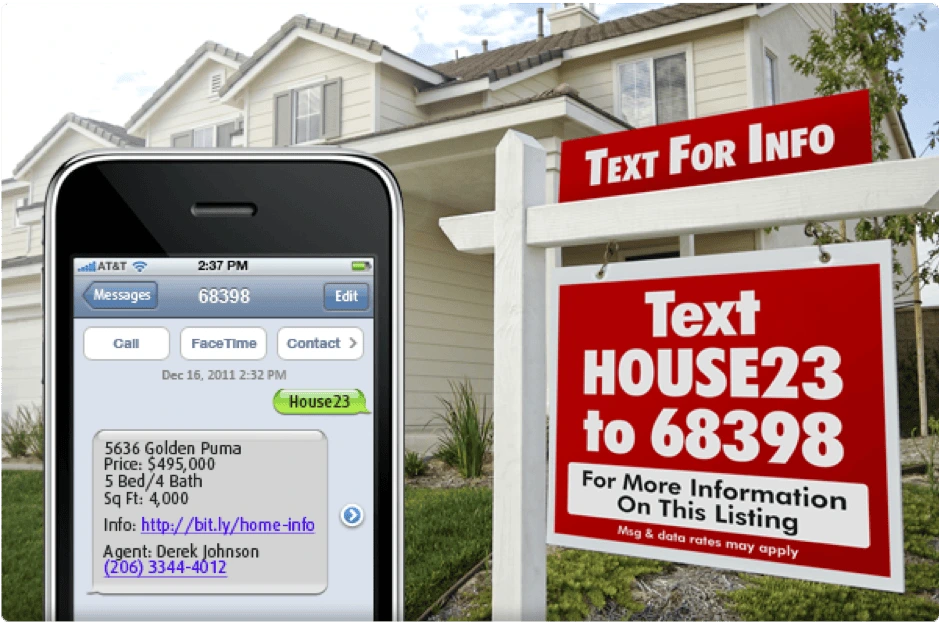
2. Asking for more information
Another fantastic way to engage your potential real estate buyers through text is to ask them for more information, based off the data you’ve already got from them—like this example:
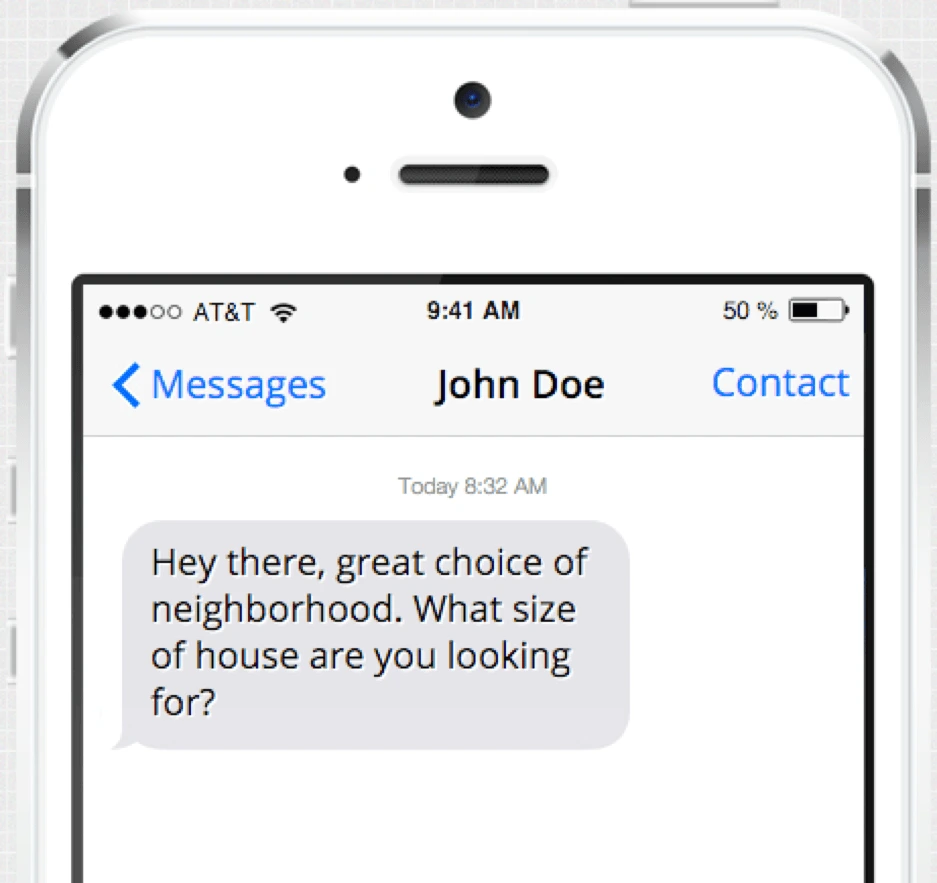
But, why does this work so well?
Well, the prospect doesn’t feel like they’re being contacted by someone out of the blue. They’ve mentioned previous information that’s already been shared (the choice of neighborhood), while asking for more in a way that prompts a response.
Key takeaway
Once you’ve made a dent in SMS marketing for your real estate company, we’re confident you’ll soon see a boost in new inquiries about your properties.
However, don’t forget that it may take some time to see results from your text message marketing strategy. Collecting customer information and perfecting your message can take a while, but don’t give up—you’re almost there.
Your brand matters. Learn how to protect and elevate your real estate brand in this branding essentials guidebook.
Have you spent thousands of dollars on direct mail campaigns with no luck?
You shouldn’t chalk it up to failure just yet. Every great marketing campaign has a solid follow-up campaign behind it.
Sending out three months of direct mail, expecting a deal to happen, and giving up is not creating a business. It’s dabbling.
On average, it takes 12 touches for a deal to happen. However, 44% of people trying to get a deal under contract give up after the first follow-up.
Related: 5 best practices of highly effective direct mail marketing campaigns
I see a lot of real estate investors sending direct mail to find off-market deals. The biggest hurdle most have is that they spend hundreds or even thousands of dollars on a direct mail campaign without obtaining any leads. Then, they send out the same campaign again the following month with the same results.
This is when most people either quit sending direct mail or buy a new list to mail because the old list “wasn’t working.” Not getting any leads from mailing a list doesn’t mean that the list didn’t work—it just means the people you were mailing weren’t ready to sell. Direct mail marketing in real estate is all about timing.
To get a consistent pipeline of deals, you have to implement a great follow-up campaign. This article will walk you through how to set your follow-up strategy.
Following up across multiple channels
The strategy outlined below uses multiple channels to complement your direct mail campaign.
Don’t worry, it’s not going to cost you much more. In fact, it’s going to make those 12 touches a little less burdensome on your budget. Let’s dive in.
Build the right list for direct mail
The first step, of course, is to send out your direct mail. To get rolling with this, start by pulling the list that you’re going to mail.
You can use a list service company like ListSource to purchase a list of people to mail. The types of lists you should be targeting are problematic lists like:
- Probate
- Foreclosure
- Tax-delinquent
- Divorce
- Vacant house
Make sure that you’re filtering out people who have little to no equity. To do this, set your filters to include people with 60-100% equity in their property. This will give you enough breathing room to get the property at a discount.
The other criteria you need to meet is Last Sold Date. We’ve had people call us and say, “I just built this house for retirement three years ago. There’s no way I’m selling it.” Granted, this may not always be the case, but we set our Last Sold Date to 8 years ago or more.
Figure out your farm area
Figure out what your farm area will be starting out. Remember that you have a smaller budget, team, and amount of time as you build momentum. Your farm area will grow as your deal flow grows. Focus on mailing an area that you can comfortably mail consistently every month.
If you work in an office, figure out the radius you want to farm around your home and work. Starting out, we chose a 20-mile radius. The distance isn’t what’s important—it’s how long it takes you to get to the houses within this radius. You don’t want to miss deals because you’re spreading your leads out too far and can’t get to all your appointments quick enough.
We recommend keeping it within 45 minutes. This will give you time to schedule multiple appointments each day as you consistently mail homeowners over time and the lead volume increases.
There’s a cool trick on Free Map Tools that lets you drop a pin, set your desired radius, and get a list of all zip codes within that radius. With this, you can easily pick the zip codes for your farming area around your workplace and home.
Optimize your postcards
What you put on your postcards is up to you, and how postcards perform in each market varies. For our market, plain white postcards with a handwritten font perform the best. (When your prospect has a stack of ten postcards that look like ads and one that looks like a hand-written note, which do you think will stand out more to that person?)
Regardless of the design, make sure you include your company’s name along with your website. The people receiving these postcards will check to see that you’re a credible company before doing business with you. We put Breyer Home Buyers and www.eastatlhomebuyers.com on all our postcards to make it easy to find us online.
If you’re sending direct mail solely to people who are going through a divorce, then you can create a divorce landing page with a URL like www.yourcompany.com/divorce. This gives you the option to retarget visitors using Facebook Ads and Google AdWords. You can do this with any mailing list: tax-delinquent, vacant houses, foreclosures, etc.
Call recipients about your postcard
Your list provider can give you phone numbers for contacts within your farm area. If you keep them in an Excel spreadsheet, you can upload them into a dialer like MOJO. MOJO lets you call hundreds of people in a very condensed timeframe. For our business, we average 71 calls per hour. Of those 71 people, we reach around 30 per hour. We use virtual assistants to call for us, which saves our company significant amounts of money.
To use MOJO, you’ll need a Skype account. MOJO connects to Skype so you can make calls within the U.S. for free, even if you use a virtual assistant.
Remember that when you’re calling prospects to follow up on your direct mail, you should mention your company’s name and that you sent them a postcard. This will jog their memory and make it more likely that they’ll look at the postcard again.
Retarget prospects with Facebook
You can use Facebook and Google Ads to retarget your prospects. Retargeting is cheaper than marketing to cold prospects with these channels. And these prospects have already seen your direct mail, landed on your website, and received a call from you. When they see your ad and click on it, they’re more likely to convert, which provides you with a higher ROI.
The other benefit is that most of us are too busy to immediately respond to marketing. Maybe your prospects were taking their kids out to eat when they drove by the mailbox and got your postcard. Maybe they were waiting on a meeting to start when they looked up your website. Maybe they lost your postcard and couldn’t find you again. Regardless, retargeting helps you pop back up in front of your prospect when they need it most.
Send an SMS blast
There’s no replacing a phone call, but sending a text message is a great way to get in touch with people who don’t like talking on the phone. We use EZ Texting to follow up with people through text. We simply upload an Excel spreadsheet of our contacts, then blast the same message to the entire list.
We usually send out open-ended questions like “Have you sold your property yet?” But, there’s no magic message. The goal is to start a dialogue, so you can make an offer to buy their property.
We’ve gotten several properties under contract without ever speaking to the homeowners on the phone, by doing all the rapport-building and negotiation over text.
Leave voicemails on landlines
Tools like Sly Broadcast let you pre-record a voice message and send it to the phone numbers on your list. It’s important to note that this service only drops voicemails to landlines, not cell phones. Using this in conjunction with the text blast will make sure you’re touching all phone types.
MOJO Dialer also drops voicemails when you’re power-dialing, but the key difference is that you are actually calling someone and will have to speak with them if they answer. With Sly Broadcast, the phones don’t ring, but a voicemail shows up on their answering machine.
Schedule your follow-up campaign
When we’re planning our direct mail campaigns, we schedule the arrival date of those mail pieces—meaning that we know (within one day) when those mail pieces will be delivered. We usually have our mail dropped on Tuesday because our response rates are higher on Tuesday.
Here’s what our follow up campaign looks like:
- Week 1: Direct mail delivered on Tuesday
- Week 1: Begin Google AdWords and Facebook retargeting
- Week 2: Cold call prospects
- Week 3: Text prospects
- Week 4: Voicemail drop
- Week 5: Repeat mailing to the same list
- Week 6: Repeat cold calling to the same list
- Week 7: Repeat texts to the same list
- Week 8: Repeat voicemail drop to the same list
With retargeting, you set it up once and keep it running. We don’t stop the Facebook and AdWords campaigns. Your goal should be to contact each prospect with a phone call, a postcard, a text, and a voicemail drop each month.
Why you should always follow up
Homeowners usually aren’t ready to sell when you first reach out to them. Granted, sometimes we do get lucky and close a deal on the first mailing. But, it usually takes us at least three mailings to get a deal from a campaign.
If you label your direct mail campaign a failure because you haven’t gotten a deal right away, then you risk missing out on future leads and give yourself zero return on your investment.
If you look out over the year and set a goal for 5 deals to get the real estate investing ball rolling, you’ll create a marketing plan to reach that goal. However, if you keep changing your marketing strategy because you haven’t given yourself enough time to make it work, then you’ll never reach it.
Ready to create your own direct mail designs in minutes? Check out our direct mail postcard templates.
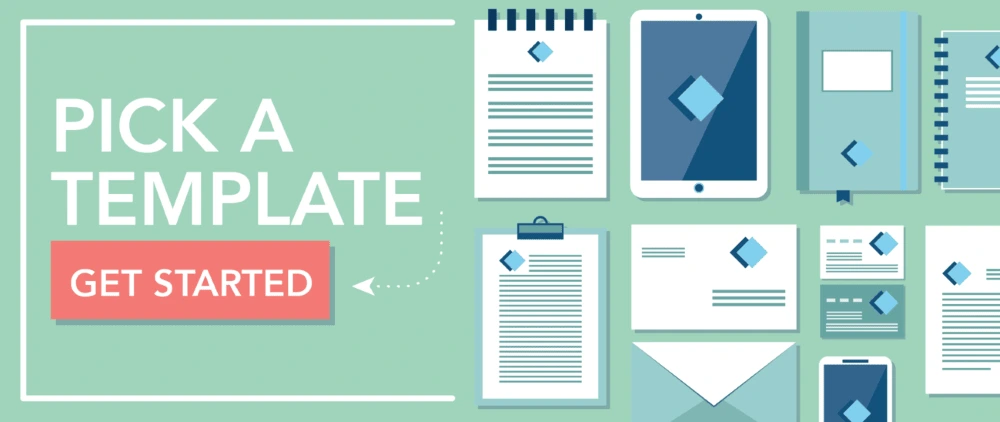
Or, learn more about the new direct mail features in Lucidpress and give it a test drive.
When you send out direct mail to prospects in real estate, it’s inevitable that you’re going to get calls from seemingly unmotivated people. If you’re not drawing motivation from your leads, then your competition will be converting your leads instead of you.
Related: How to follow up your real estate direct mail campaigns
Based on the process I use for my own business, this article will teach you how to answer calls from inbound leads and how to handle appointments.
Follow a call frame
A lot of gurus will provide everyone with a script, but if you’re following a script and the conversation steers away from it, you’re going to sound salesy and unnatural to your leads. You need to have a frame to work with rather than an exact word-for-word script, because the nature of your calls will be dynamic.
We follow a call frame that looks like this:
- Set your time frame.
- Set your agenda.
- Determine your outcome.
This makes your conversations feel more natural, giving you room to implement strategy as the opportunity occurs (instead of trying to bend the conversation to your will).
Set your time frame
Whether someone calls you in response to your direct mail campaign or you’re just returning their call, the prospect has no idea what to expect. Our goal is to inform them, so we put them more at ease.
Of course, sometimes the timing isn’t ideal. What if your prospect was taking a break at work when they called you, and by the time you call back, they’re hiding in their cubicle and whispering to avoid being overheard? You won’t be able to take them through the entire sales process on the call, cutting yourself short.
To avoid being cut off, we always begin the call by letting them know it should only take about 5 to 10 minutes, and we make sure that works for them. Most of the time, it does. On the rare occasion that it doesn’t, we schedule a time to call back when they’re able to talk. We want their full attention—so they aren’t focusing on when they have to get off the phone.
An example of how this introduction might sound:
“This call will take me 5 to 10 minutes to answer all of your questions, ask you some of our own questions about the property, and explain what the process will be moving forward if we decide that this house would be a good fit.”
Set your agenda
Along with setting the time frame, the introduction needs to tell the prospect what will be happening on the call. Remember, they don’t know what to expect. Most likely, they’re on guard.
We set the agenda of the call by acknowledging that they probably have a few questions for us, assuring them that we will answer their questions. We add that we have a few questions for them, and that if we are a good fit for them, we’ll proceed to the next step in the process.
When you set an agenda with your prospect, you’re building credibility and trust. You’re handling the call in a professional manner that sets you apart from your competition—especially when they’re getting handfuls of direct mail saying “We buy houses.” We’ve gone to appointments where homeowners had stacks of direct mail from real estate investors. Going the extra mile to build trust will definitely help you stand out.
Acknowledge their questions
When you mention that you’re aware they probably have questions, you’re giving them permission to ask all the questions they want. After all, selling a house to an investor is a big deal.
People traditionally sell houses through a realtor, which can take months to close. With an investor, it could take only a couple of weeks. There are lots of questions lingering in a seller’s mind, and they deserve to ask and be reassured that this is right for them. Transparency will only help you.
Inform them of the next step
Near the end of the call, we usually know whether or not it makes sense to move forward. This is where you remind them that, if this isn’t a good fit, it’s totally okay to say no. People love being able to say no because it gives them a sense of freedom and comfort in the process. They know that you won’t pressure them if they decide this isn’t the route they want to take. Once you take the pressure off, you can really dig into the motivations of the seller.
“If you’d like to get our best offer on the property, we’d have to come out to see it and verify that the conditions match our repair estimates. The appointment should only take 30 minutes to an hour. We’ll just walk through the property and check out the condition. After that, we can make you an offer, down to the penny. If that works for you, I can schedule the appointment for Monday at 1 p.m. or Tuesday at 9 a.m.”
Determine the outcome
Do you ever find yourself hanging up the phone with an inbound lead, wondering how the phone call went? Determining your outcome on the phone and setting expectations provides clarity on what you need to do next in the process—whether that’s determining it’s a dead lead, dropping them into the follow-up process, or going to an appointment.
So, you’ve determined that the prospect needs your services while on the phone. You’ll want to explain what the process looks like at the appointment. This includes how long it takes, what you’ll do at the property, when they can expect to receive an offer, and what their options are. After explaining this process, set the appointment. Now you and the homeowner have a clear idea what’s going to happen next.
If you determine that your services don’t align with the homeowner’s needs, then explain to them that you don’t want to waste their time and you don’t believe you’re the best solution for them. Always genuinely offer to point them to a service provider who could help them. Offer your network of real estate agents, property managers and contractors to see if you can help them further.
Determine their motivation
The goal of any call with a prospect is to determine their level of motivation. One way to gauge this is to “go negative.” This simply means to pull back from them throughout the conversation.
The analogy goes that, if you chase a dog, they will run away. But, if you run away from a dog, they will chase you. Going negative will help you determine if the person is a legitimate lead, meaning you’ll know whether they have a problem your company can truly solve. Simply put, you just act a little less interested in your prospect to see if it makes sense to do business together.
Examples of going negative:
- “It seems like a great property. I’m not sure why you would want to sell it.”
- “It seems like this property would make a great rental. Have you considered just keeping it and renting it?”
- “It sounds like you’re looking for top-dollar on the property. Have you considered listing it with a realtor? It’ll take a little longer, but you’ll get the most money.”
There are two benefits to using this strategy. One, you’ll flush out all the normal objections a potential seller could have by bringing them up first (prompting them to justify why that won’t work). For example, you might hear something like, “No, I hate working with realtors. I just want to sell it and be done with it.”
Flushing out the objections will clear a path for you. As investors, we have to make lower offers so that we can turn a profit for our business. If you don’t flush out the objections, you will get responses like, “You know what? That’s a little low. I think I’ll just keep it as a rental or list it with a realtor.” After you’ve flushed out these objections, they can’t use them anymore. They just told you they didn’t want to keep it, rent it or list it.
The second benefit is that you determine their motivation. Sometimes, we cover so many objections that sellers just say, “I don’t want to do any of this. I just want to sell it to you guys and be done with it. Give me an offer.” In the seller’s mind, you’ve become their best option.
“Just give me an offer.”
We encounter it daily. People will put on their negotiation mask and demand an offer over the phone. When we started up our business, we’d always try to justify why we need to see the property to verify its condition. It hardly ever worked.
So, we switched up our approach. When someone demands an offer from us right away, we ask, “Would you rather have an offer, or would you rather have our best offer?”
The obvious answer is that they want our best offer. At this point, sellers usually quit hassling us about getting a quick offer. We explain that, to make an intelligent offer, we need to see the property and make a list of repairs needed to get the offer down to the penny. This flushes out people who are simply shopping offers, and it saves your company time and money when you avoid them.
Key takeaway
Now you have a call framework to draw out motivation from your direct mail inbound calls. Don’t get caught up in the nitty-gritty of a script. Instead, focus on getting your prospect’s guard down, setting expectations, going negative to gauge their motivation, and setting an appointment with them.
Want more great tips on how to set up real estate marketing campaigns? Check out our comprehensive real estate marketing guide for ideas & inspiration.
One of the biggest challenges realtors face in today’s market is the planning and implementation of an effective real estate listing marketing plan.
The opportunities and expectations have changed and grown exponentially over the past decade or so, and with so many avenues and moving parts, it’s not easy to nail down a real estate marketing plan and stick to it.
Related: How to build a social media campaign for real estate (with templates)
The benefits of getting it right, however, can be huge, so it’s a challenge that every determined broker or agent needs to overcome.
Components of an effective real estate listing marketing plan
First, as a small or medium-sized real estate agency, you need a listing marketing plan that’s high-impact.
Why? Because you need every dollar to count. You don’t have the budget for this to be solely about brand identity—you need to move real estate listings consistently.
By building an intentional and strategic marketing plan, you’ll increase your chances of getting that tenfold. So, where do you start?
The important thing to understand is that every element that makes up your real estate marketing ecosystem should be connected, usually in more ways than one. That’s how you move your audience through the sales funnel.
To achieve that, you’ll need to start with an overview: a top-level view of how each aspect of your plan links together. A simple diagram will do the trick here, so long as it gives you a clear view of how everything is connected.
Start by creating a goal and measurable objectives for your marketing plan. Think of your goal as your overall vision for the plan. For example, a listing goal could be selling a listing at above market value. Measurable objectives could include having a certain number of attendees at an open house or a certain number of emails or phone calls from a direct mail campaign.
Once you’re goals are in place, it’s easy to identify which marketing strategies and tactics you should focus on in your plan. In your diagram, start with your goals up top. Then link to your objectives and list each strategy under that.
Once you have that, you can begin to look at each element individually to ensure you’re maximizing its effect. More on that shortly.
First, a reminder that this isn’t about throwing out the feelers to see what sticks, only to try the same thing again next year because you’re not sure what really worked.
For everything you do, you’ll need to follow these three critical steps:
- Measure
- Analyze
- Refine
If you’re serious about making this work, you must implement processes for measuring your efforts. Then, once you’ve got the data, sit down with all key decision makers to analyze what’s working. From there, you’ll be able to refine your plan and make improvements for the next phase.
Creative marketing ideas for your listings
Now, let’s look at some of those individual elements of the real estate marketing plan in more detail. And remember, in everything you do, look for ways to connect your activities and move your leads through the sales process.
Door-knock in the local area
To get ahead of the game before your listing gets published, why not canvas the surrounding properties?
Your sellers’ neighbors might know someone who’s looking to move into the area. They may even be interested themselves.
Briefly describe the house or property, or show a flyer if you already have one, then open up a conversation about any potential interest.
Don’t forget to leave them a card in case an idea comes to mind later, and be sure that this card connects them with other elements of your marketing.
Post a “coming soon” photo online
Another way to get a head start with marketing listings is to preview the property online or on social media before the full feature goes out.
Take an appealing, well-lit photo showing off one of the property’s best aspects or features. Post it with a caption that drives curiosity and engagement.
To ensure this element fits within your strategically connected marketing plan, you’ll need to think carefully about when and where you’ll release further information. How will you make sure any early interest is followed up on? Perhaps you could ask your audience to subscribe to a mailing list to be the first to find out more.
Hire a professional photographer
An absolute must, if you want to compete in today’s real estate market, is quality photos. With so much competition for consumers’ time, especially online, publishing quality images is a good tactic for capturing attention.
Invest in professional shots that show your listing in its best light and you’ll stand a far better chance of attracting buyers.
Use as many photos as possible
Similarly, your listings will carry more appeal if you include at least 12 photos. In fact, the more the better. Don’t be afraid to use upwards of 20 or even 30 if you can.
Try to show each room from different angles, as well as the exterior from various viewpoints. You could even include photos of the views from the front and back of the property, as well as capturing the outside spaces.
Do everything you can to help potential buyers visualize themselves in the property.
Use video
Reports from the National Association of Realtors show that 85% of buyers and sellers prefer to work with an agent who offers video, yet only 15% of agents use video when marketing listings.
Get ahead of the curve and take your listings to the next level with video tours and 360-degree images or clips. Not only will this help you stand out and attract more interest online, it’ll help potential buyers feel more familiar with the listing from the start.
Related: How to create stellar videos for real estate listings
Be descriptive and emotive
Take the guesswork out of it and help buyers connect with the property by including detailed, descriptive summaries of your listings.
Look for opportunities to add character and memorable details. Use language that evokes positive memories and emotions.
Most of all, remember that good advertising copy doesn’t just list the features, it sells the benefits. Paint a picture of how good life or business could be for your potential buyer and you’ll be helping them form an emotional connection.
Produce quality marketing materials
Though it might seem like it sometimes, it’s not just the online channels that matter. Direct marketing (that’s flyers, brochures, letters or postcards sent to mailboxes or posted through doors) still has its place. In fact, it can even yield higher results.
But, like with any investment you’ll make in marketing collateral, it’s only worth adding it to your real estate marketing plan if you’re going to do it well.
Choose high-quality paper, use professional photos, and keep your branding consistent across all channels and materials. When it comes to adding a call-to-action, think carefully about what you want the reader to do next. Should they visit the website or call you directly? How will you move them through the sales process?
Related: How to follow up your direct mail campaigns
Feature the listing in your newsletter
When it’s maximum exposure you’re looking for (which is most of the time when you’re marketing listings), you’ll need to take advantage of every channel you have.
Your agency’s newsletter, if it’s been managed well, should be a direct line to your most engaged audience, meaning there are potential buyers on that mailing list waiting to hear from you.
Take advantage by featuring your listing in the next edition and be sure to let all recipients know where they can go to find out more. Remember—a connected marketing strategy is what you’re aiming for here.
Related: 8 tips to get more responses to your email marketing
Send the listing to other agents
Make use of your network to enhance the success of your listing marketing by sending out an email to introduce the property.
Ask your contacts if they have any buyers who might be interested and offer them the same support in return.
It’s through building relationships and partnerships like this that some agents are able to maintain a consistent income.
What if it still doesn’t sell?
When you’ve completed every strategy in your marketing plan and a listing still isn’t selling?
While the seller might expect you to spend more on advertising, you know deep down that it’s the price that needs to change.
Remember this phrase and use it to help explain your position to your clients: “If it’s not compelling, it’s not selling.”
There are typically three types of listings that can be compelling at a higher-than-average market price. These listings are opportunity properties, exclusive properties, and turnkey properties with no competition.
For everything else, the price matters, and if it’s not compelling, it’s not selling.
To soften the blow of a drop in price, make an effort to understand your seller’s point of view. Often their ideas will be based on what they’re hearing in the national media, which you know doesn’t always translate locally.
Break down the data for your clients by showing them the statistics in four different subsections:
- National
- State
- City
- Community
Once they see the difference laid out in front of them, they’ll find it easier to accept your push for a more compelling price.
Once they’re convinced, you can make it compelling, create excitement and then—potentially—you’ll have a bidding war on your hands.
Key takeaway
The key to building an effective real estate marketing plan is to connect the many elements and moving parts. If you can do that well and use those connections to guide potential clients towards your end goal, you’ll see consistent results and a strong ROI.
Want more great tips on how to set up real estate marketing campaigns? Check out our comprehensive real estate marketing guide for ideas & inspiration.
When you’re selling properties with a hefty price tag, attracting new customers isn’t the easiest thing in the world—especially since they’re only likely to buy if they’re actively looking for a new home.
Despite the fact that the number of leads generated for real estate companies has increased by 65% since 2016, the conversion rates of those leads are tanking. It’s not as easy to take a prospect from initial meeting to sale completion as it once was.
Related: 8 tips to get more responses to your email marketing
However, there’s one thing you can focus on to change the story: Email marketing. In an industry where high-ticket items are a huge investment, email marketing could be the perfect channel for you. That’s because consumers who purchase through email spend 138% more than those who don’t receive email offers, on average.
That’s right: By diving into the inbox of your potential clients, you’re etching your real estate brand in their mind. Then, when they’re ready to take the next step and purchase a new home, they’ll come to you—rather than the other way around.
If you fancy making that dream a reality, follow this guide to real estate email marketing.
How real estate companies can use email marketing
Are you ready to hit “send” on your emails and fire off a message to everyone who’s contacted your real estate company?
…That might not be the wisest idea.
There’s a whole list of things you need to do before sending an email marketing campaign, and here, we’ll cover a few of the major ones.
1. Collect information on potential customers
You can’t email people who might be interested in your properties if you don’t have their contact details. Sounds obvious, right? However, you don’t want to contribute to the 79% of marketing leads that never convert to sales.
So, start your real estate email marketing campaign by making sure you’re emailing the right people. You could attract potential clients (and convince them to handover their email address) by:
- Creating a free ebook on a relevant topic but asking for their email address in return.
- Asking people who’ve inquired about a property whether they’d be interested in receiving your newsletter.
- Running Facebook ads which ask target customers to fill in a form and receive a brochure via email.
Just take a look at this ebook, created by The Kingdom Real Estate, which helps to collect leads from their website:

Because the free ebook is gated and requires an email address to access, it’s a fantastic way to add warm leads to your email marketing funnel.
But, this step comes with a warning: Always make sure you’ve got permission to contact the person you’re emailing—especially if they’re located in the EU. You don’t want to land yourself a hefty fine for going against GDPR regulations.
2. Create a perfect subject line
When you’re sending an email, the subject line is almost—if not more—important than the email itself. Why? Because 47% of email recipients decide whether to open an email based on the subject line alone.
If you’re not crafting an interesting subject line that piques your audience’s attention, there’s a high chance your email will head straight to their virtual trashcan. Research has found that the best subject line:
- Contains 6 to 8 words (source)
- Includes the recipient’s first name (source)
- Has a sense of urgency (source)
Use these best practices when piecing together the tagline of your real estate email marketing campaigns before hitting send.
3. Write (or share) something valuable often
Think about the last time you opened an email in your inbox. (It doesn’t have to come from a real estate company.)
What made you open it?
Chances are, the message didn’t land in your trashcan because it contained something of value to you. Whether it contained a discount code for your favorite store or a free guide to something you’re struggling with, your customers are the same.
They’ll only open and respond to emails they get value from.
Your real estate business can use this concept by asking yourself, “What value am I providing in this message?” before hitting send on your latest campaign. That could be:
- A message to let them know about a discount on a property they’ve inquired about.
- A discount on realtor fees if they’re looking to sell their current home.
- A solution to one of their pain points.
In short: If you’re not giving value to your subscribers, think twice about sending it. You don’t want to be seen as the annoying company who constantly sends self-promotional messages. That’s only going to lead to an unsubscribe.
4. Analyze what’s working
You’ve built up the courage to hit “send” on your email after working hard to perfect the subject line and email copy. What happens next?
Well, like any new real estate marketing campaign, you’ll need to analyze whether your new strategy is working. It’s the only way to know whether it should play a key role in your marketing plan, going forward.
To do this, head to your email software and analyze key metrics like:
- Open rate. What percentage of people received your message and opened it?
- Click-through rate (CTR). Did many people click the link in your email?
- Response rate. How many people hit the “reply” button and started a conversation off the back of your newsletter?
- Conversion rate. How many people made a purchase as a result of your email?
Your goal here is to find a common denominator across high-performing emails and replicate that moving forward. For example, if the emails with the highest click-through rates contained emojis, build this into your set of email marketing best practices in the future.
Tools for real estate email marketing
Using the right tools will help you be more efficient and effective at your email marketing. To start, you will want to select an email marketing tool that can collect contact information, segment lists and schedule emails. For agents starting out with smaller lists, a service like MailChimp or Constant Contact will provide the basic functionality you need.
In addition to managing your email list, you will need a tool to help you design your emails and generate content for your email campaign. Lucidpress offers an easy-to-use design tool with social media templates, infographic templates and flyer templates to get you started. You can also design the entire email in Lucidpress with one of our email newsletter templates and use our ConstantContact integration to send your emails straight from Lucidpress. Or generate HTML code and paste it into any email provider of your choice.
Bonus: Free real estate email marketing template
Are you ready to put these tips into practice?
If you’re still hesitant, don’t worry. Writing email messages to your potential customers can feel daunting—which is why we’ve created a free email marketing template you can use to push subscribers back to your website.
Simply edit the capitalized text, add your own personal touches, and you’re good to go.
Subject line: ? NAME, here’s a free guide to BLOG POST TOPIC
Message:
Hey NAME,How’s it going?
Here at COMPANY, we’ve been working hard on RECENT ACTIVITY. In fact, we’ve listed X new properties this week! (That’s no easy feat.)
To top it off, we’ve just published a guide to BLOG POST TOPIC.
Including DETAIL #1, DETAIL #2 and DETAIL #3, it covers some of the most common issues we see with home-buyers-to-be.
Click here to give it a read: LINK
If you’ve got any questions, ideas or suggestions for this guide (or anything we talked about in it), drop me a line. I watch my emails like a hawk, and I’ve always got time to chat with you, NAME.
Best,YOUR NAME
Key takeaway
As you can see, email marketing is a fantastic way for real estate companies to generate more leads—and turn those people into paying customers through your email workflows.
By committing to a weekly newsletter or regularly sharing free value with your subscribers, there’s no reason why a few tweaks to your email marketing strategy couldn’t be the best thing you’ve done for your business lately.
(At least not when you’re using our templates.)
Your brand matters. Learn how to protect and elevate your real estate brand in this branding essentials guidebook.
Last week I received a letter in my mailbox for the first time in a long time. It’s been ages since someone (even a company) sent me physical mail rather than going the easier route with email.
It really felt good to have something that I can touch and feel with my own hands.
Related: 11 best direct mail pieces to inspire your next campaign
Sometimes, the dull and boring side of advanced technology makes us realize we’ve come a long way. There was a time when people used to get a lot of mail in their mailboxes, especially in the form of promotional material.
Gradually, companies left that behind and considered it defunct. But in reality, direct mail is still a great way to engage with one’s audience.
Why? Because in our modern age, it provides a personal touch that email can never replicate. Data published by the Data & Marketing Association in 2016 showed that the response rate of direct mail increased 43% year-over-year. This is a huge leap from previous years.
Companies should know that it’s short-sighted to completely do away with direct mail. It’s still an effective and useful tool. To drive home the point, here are eleven reasons why every brand should (re-)consider direct mail.
1. You can achieve a higher ROI
Most companies set up online ads hoping to see better ROI because of the huge number of internet users.
But, direct mail can drive even better impact: a median ROI of 29% compared to online display at 16%.
When someone receives physical mail, it carries more weight (and not just literally). Customers are more likely to respond to communication that feels personal, and direct mail makes it easier to send that message.
2. Direct mail pairs well with digital marketing
If you want to build your own brand online or enhance the reputation of your company, digital marketing is usually the best place to start.
For many brands, this includes publishing SEO-optimized content and setting up Facebook ads. It usually doesn’t include direct mail… but maybe it should.
Direct mail can help you bridge the gap between the digital world and the real one. You can reach potential customers who might otherwise never hear about you—and you don’t always have to sacrifice data to do it.
For example, a digital marketing agency in our own state (Utah) included a scannable code on the back of one direct mail piece. They could track engagement with that code just like they would any other online campaign. They also included a Twitter hashtag that people could use to interact with the campaign. These techniques help to tie everything together, so their team got a holistic look at their campaign’s performance.
3. You can hold direct mail
This might seem obvious, but humans are sensory creatures. An email lives on your digital gadgets, where you’ll never be able to touch it. People can actually touch and feel the direct mail that a company sends to them, and because of that, it leaves a stronger impact.
This is especially valid for pieces that provide real-world value, like a free sample or discount coupon. Customers are more likely to remember and redeem those promotions than the ones they’re inundated with via email.
4. Attention, please!
When people check their mail, they take and go through everything they’ve received. It’s almost guaranteed that they will look at each and every piece, even if it’s only for a moment. Then they have to decide what to do with each piece—deciding which ones are worth saving and which ones are okay to throw away.
Conversely, when someone’s checking their email, they’re often engaged in other behaviors and environments that divide their attention. For example, they could be multi-tasking at work or watching TV on the couch. Since direct mail deals with fewer distractions, it benefits from better attention spans.
5. You can track direct mail
There are plenty of email & direct marketing tools to track the progress of your email campaigns. What about direct mail? Yes, it’s true that the process isn’t fully automated in the same way—but you can make them easier to track.
For example, you can designate a phone number or email address solely for the target audience of your direct mail campaigns. You can also create specialized landing pages with unique URLs. This will greatly improve the quality of your data and the accuracy of your success metrics.
6. All ages welcome
Any time you opt for a particular marketing strategy, it’s vital to understand which age groups that strategy serves.
In the case of email marketing campaigns or online advertisements, seniors are often left out because they adopt technology later than the younger generations. If seniors are a key demographic for you, you’re probably leaving money on the table.
Instead, consider reaching that audience with direct mail. And don’t assume seniors are the only ones—other audiences could benefit, too. Take a look at your audience and think about whether direct mail could extend your reach.
7. When others zig, you zag
Since digital marketing has so thoroughly transformed the landscape, many companies have quit using direct mail altogether. Just because fewer people are using it, however, doesn’t mean it’s an obsolete tool.
In fact, there’s a little bit of irony at play here: Your brand can stand out by reincorporating direct mail as part of your campaign. The high ROI speaks for its validity, and you can get the best of both worlds by adding physical mail to your digital campaign.
8. Direct mail can help you target specific audiences
We’re used to seeing the targeting capabilities of various social media platforms. But, did you know that direct mail can also target specific audiences?
For example, the USPS website has a tool called Every Door Direct Mail, which lets you send mail to addresses within a selected geographic area. This is the same system Lucidpress uses to send direct mail postcards from our platform to the local areas you want to target.
It’s not only about location, though. Address databases often contain other details you can use to target an audience: age, income, marital status & more. With these, you have granular control over who to send your direct mail to.
9. You can raise brand awareness
Are you trying to raise awareness of your brand? If you’re willing to build a campaign around that goal, direct mail can be a very effective way to achieve it.
As always, brand consistency is key, so keep your direct mail pieces consistent with overall branding.
You can earn extra points by including a coupon or another special offer, increasing the likelihood that your recipient will keep it around. The more times they view your direct mail piece, the more familiar your brand will feel to them.
10. Direct mail tickles the senses
Quick: name the five senses. Now, name the senses you can activate with a digital marketing campaign. Suddenly, your options are a lot more limited.
Sensory experience is a huge part of getting a response from an audience. If you’re only marketing online, you’re limiting yourself to sight and sound.
With direct mail, you can activate more senses like smell, taste and touch. (For example, think about those perfume ads you used to find in magazines.)
The more senses you can trigger, the more likely your customer will be moved by your message.
11. You can let your creative juices flow
In digital marketing, where best practices and A/B testing determine all, have you noticed that most company websites look… pretty similar?
Refreshingly, direct mail is a channel that brands can experiment with to create something new and innovative.
In fact, the more your mail stands out, the better. Take a look at some of the fun, creative ideas in this Pinterest board of direct mail marketing ideas:
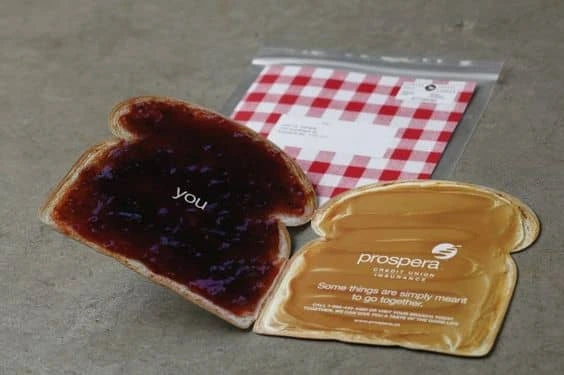
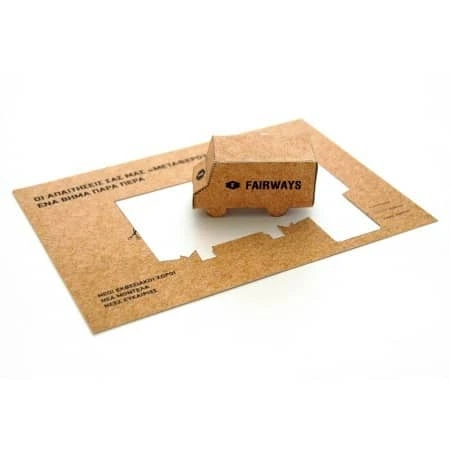
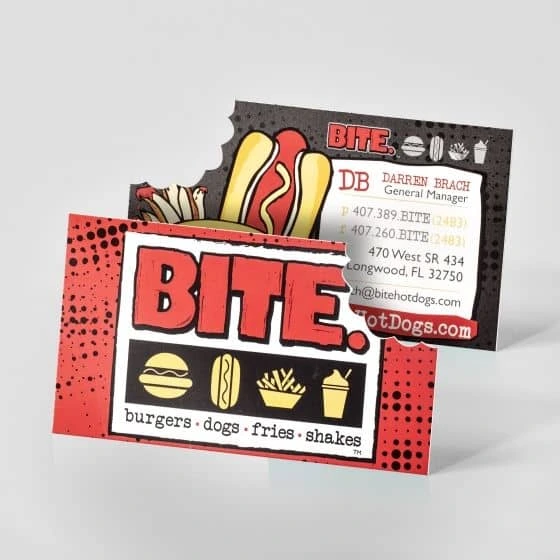
Key takeaway
Cutting direct mail from your marketing strategy because you assume it’s dead is misguided. Direct mail is still alive and well, and there are strong reasons to include it in a well-rounded campaign.
From higher ROI to stronger impact, brands are still reaping the benefits of direct mail today—and so can you. Bring these eleven reasons to your team the next time you’re planning a marketing campaign. They might just be surprised at the results.
Ready to build your own campaigns in minutes? Learn more about the direct mail features in Lucidpress, and give it a test drive.
Not too long ago, frozen yogurt shops were popping up all over the place. You could create a delectable dessert that was perfect for your tastes because, well, it was created just for you.
Imagine this same approach but in marketing form.
That’s pretty much the idea behind content personalization: the practice of tailoring a user experience to each customer or client. Content personalization creates a unique experience for your clients that can’t be replicated anywhere else.
This type of personalization is important to you because it can equate to keeping customers on your site longer and driving improvement in conversion rates and revenue.
Growth of content personalization
Thirty years ago, our access to content and information hit the acceleration button. On average, you could expect to see about 2,000 ads per day. Today, that number is closer to 10,000, and it’s only increasing due to the growth of content personalization.
The internet allowed the business world to create and publish content for a broad audience that had been inaccessible up until this point. By 2010, the world hit content overload, with over 152 million active blogs. To stand out from the noise, businesses have adopted content personalization as a way to entice viewers to engage with their content.
Benefits of content personalization
Content personalization is valuable. And must be part of your content strategy. The numbers speak for themselves.
- 55% of marketers say personalization increases visitor engagement
- 55% also say personalization improves the customer experience
- 51% say personalization increases conversion rates
Principles of a cohesive, personalized content experience
With the growth of content personalization, the world has become inundated with personalized ads. It’s now expected by customers and clients to see personalized content. Because of this, you need to look at content as a critical part of the customer experience and not just a marketing activity. To do so, you should follow these three principles of the personalized content experience.
Consistency
Your messaging and branding should be consistent at every point in the customer journey. And becomes even more important when developing a personalized content journey. Doing so can be challenging to accomplish, especially as more than just your marketers may be producing content for your brand. In a study of marketers and brand managers, Lucidpress found that consistently presented brands are three to four times more likely to have brand visibility. As you start moving forward with better, more personalized content for your audience, check out Lucidpress’s content marketing platform. It can help your marketers plan and create content while keeping it all in one place.
Scalability
Along with consistency, it’s important to make content accessible by creating a central source of truth and providing tools that non-designers can use to quickly personalize content while staying on-message. A great way to achieve scalability is to create templates of brand media that everyone within your organization can access. Templatizing your brand media provides brand control while enabling everyone to personalize content. This principle can also cut out mundane requests for your design team.
Redefine personalization
Now that you have resources in place, it’s time to redefine your idea of personalization. Personalized content is agile and genuinely reflects your customers. By redefining personalized content, you can start creating content that is so personalized that someone who isn’t a member of that audience doesn’t have the context to get the joke. It will provide extra delight to your desired customer and filter out those who aren’t your targeted audience. To achieve this you must first collect the data you need to understand your customers, distribute that information across your organization and then make personalization easy by creating content that is built to be dynamic.
Examples of content personalization
Accomplishing personalized content can be done in several different ways and across many different platforms, from individually tailored emails to product recommendations. Here are a few examples of things you can do to personalize your content.
Hubspot
Social media is an easy way to gain insight into what your customers are looking for, their pain points, and more. Hubspot leverages this plethora of available information and transforms it into personalized content that addresses customer issues and needs. From there, Hubspot applies the content strategically based on the prospect’s location in the customer journey, which creates more reliable leads and elevates the overall customer experience.
TLDR: From the horse’s mouth — use customer feedback and various other insights to personalize content production.
Slack
Content personalization also involves understanding your various channels. Slack provides a product that makes it easier for teams to collaborate, chat, share files, etc. They have a heavy social media presence, hitting the main platforms, plus a podcast and several blogs. Slack uses every one of these channels to connect with their customers. By being present on each of these channels, they can strengthen their brand identity, build trust and credibility, and start conversations with prospective clients. Because they’re on various channels with different content for each, they can reach a wider audience. Like Slack, you can also use social media to get inside info on your customers and provide even more personalized content.
TLDR: Get social — use social media to build trust and communicate with customers in a digital, yet personalized setting.
Shutterfly
Content personalization can be applied within the product as well. Shutterfly is an app and website that allows you to create photo books, calendars and more with your personal photos. When using their app, Shutterfly can access your photos and then identify pictures with faces in them and place them on items you can purchase from within the app. If you sell products that are already personalized, it can help to show your customers what they may look like before buying them, or even show them what they can do with your product.
TLDR: Lead by example — give your customers reason to see themselves [in your product] by showcasing their peers using it.
Today’s marketers have countless opportunities to create personalized content experiences. And as we mentioned earlier in the article, your customers have come to expect this, too. For many organizations, creating content personalization can feel trivial and overwhelming. But as you start to create better content and forge lasting customer relationships, be sure to check yourself and read our guide on how to deliver the extra 1% and provide customers with a memorable content experience.
Summoning creative inspiration can be a little like eating peanut butter on saltines while you’ve got cottonmouth. In other words: It can be difficult.
If we’re being completely honest, it’s safe to say that some days are just harder than others. And on those days, it’s easy to feel lonely in your pursuit of content marketing. But here’s the thing — you’re not. You don’t have to fly solo or reinvent the wheel. There’s a whole big world of marketing experts out there, replete with wonderful knowledge, sage advice and whatever else you can dream up.
So whether you’re crafting up a blog post like yours truly here, designing a bland (but “make it inspired!”) marketing brochure or wrangling some content for social media, you can look to our listicle of marketing quotes to get you jump-started — or to share with others!
Famous marketing quotes
“People don’t buy what you do, they buy why you do it.”
Simon Sinek
“Instead of interrupting, work on attracting.”
Dharmesh Shah
“I’ve learned that people will forget what you said, people will forget what you did, but people will never forget how you made them feel.”
Maya Angelou
“Good marketers see consumers as complete human beings with all the dimensions real people have.”
Jonah Sachs
“Our job is to connect to people, to interact with them in a way that leaves them better than we found them, more able to get where they’d like to go.”
Seth Godin
“Marketing is really just about sharing your passion.”
Michael Hyatt
Branding marketing quotes
“It’s quite fun to do the impossible.”
Walt Disney
“Behind every piece of bad content is an executive who asked for it.”
Michael Brenner
“A brand is no longer what we tell the consumer it is — it is what consumers tell each other it is.”
Scott Cook
“Making promises and keeping them is a great way to build a brand.”
Seth Godin
“Your brand is a story unfolding across all customer touchpoints.”
Jonah Sachs
“Do one thing every day that scares you.”
Eleanor Roosevelt
Social media marketing quotes
“Content is fire, social media is gasoline.”
Jay Baer
“Social media is about sociology and psychology more than technology”
Brian Solis
“Build it, and they will come” only works in the movies. Social Media is a “build it, nurture it, engage them and they may come and stay.”
Seth Godin
“Social media is about the people. Not about your business. Provide for the people and the people will provide for you.”
Matt Goulart
“Social media requires that business leaders start thinking like small-town shop owners. This means taking the long view and avoiding short-term benchmarks to gauge progress. It means allowing the personality, heart, and soul of the people who run all levels of the business to show.”
Gary Vaynerchuk
Content marketing quotes
“You can’t sell anything if you can’t tell anything.”
Beth Comstock
“Content builds relationships. Relationships are built on trust. Trust drives revenue.”
Andrew Davis
“Not viewing your email marketing as content is a mistake.”
Chris Baggott
“Whether B2B or B2C, I believe passionately that good marketing essentials are the same. We all are emotional beings looking for relevance, context and connection.”
Beth Comstock
“What separates good content from great content is a willingness to take risks and push the envelope.”
Brian Halligan
“Quality content means content that is packed with clear utility and is brimming with inspiration, and it has relentless empathy for the audience.”
Ann Handley
Storytelling marketing quotes
“Marketing is no longer about the stuff that you make, but about the stories you tell.”
Seth Godin
“Good content isn’t about good storytelling. It’s about telling a true story well.”
Ann Handley
“I’ve learned that people will forget what you said, people will forget what you did, but people will never forget how you made them feel.”
Maya Angelou
“If your stories are all about your products and services, that’s not storytelling. It’s a brochure. Give yourself permission to make the story bigger.”
Jay Baer
“The most powerful person in the world is the storyteller. The storyteller sets the vision, values, and agenda of an entire generation that is to come.”
Steve Jobs
At the end of the day
“Inspiration doesn’t respond to meeting requests. You can’t schedule greatness.”
Jay Baer
Your brand needs to go the distance. A memorable brand shows up for their customers. But, cultivating that type of experience is a whole other story. Because regardless of your role in marketing or what type of marketing content you’re creating, knowing and understanding the effectiveness of your content is the key to being “that brand” for “that customer — learn more about what constitutes effective content and how to begin nurturing it for your brand.
Data-driven decision making has gained increasing importance in marketing over the past few years due to the high availability of tools and sophisticated Martech stacks. The results? A level playing field that allows even small businesses to measure and act on customer data. It seems that nearly all companies are doing all they can to gather more market research and sales data — and what they can do to understand data implications better and apply it more effectively.
According to the joint survey published by the DMA and Winterberry Group, 40% of marketers said their companies intended to increase budgets for data-driven marketing somewhat and/or significantly. The most common marketing applications for data-driven decision making include customer journey analysis, A/B testing and personalization. While all of these are influenced by content, 44% of the respondents specifically chose copy optimization.
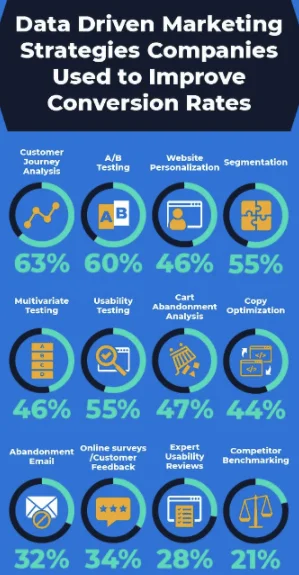
Source: https://www.invespcro.com/blog/data-driven-marketing/
There are undoubtedly countless benefits to relying on data to guide all types of strategies — but when it comes to content marketing, applying data insights can feel somewhat complicated. From what we’ve seen, marketers consistently struggle with proving ROI for content, and it seems that applying data insights can cause additional issues.
Before Covid-19 made a mockery of all surveys, opinions and empirical findings, the WARC reported in 2019 that big data management and digital transformation were among the top three challenges marketers faced across the board.
This finding leads many marketers to wonder — do all content marketing decisions need to be driven by data? What is the data’s place in developing and executing a successful content marketing strategy?
To that end, we’ve compiled a list of need-to-knows that all marketers must consider when applying data to the content creation process.
Content marketing doesn’t always deliver measurable results
One thing that sets content marketing apart from other strategies is its intention. More often than not, content creation aims to cultivate brand awareness and help customers along their journey rather than directly influencing sales.
Marketers use digital formats like blog posts, podcasts or content hubs to support the site’s overall searchability and drive in organic traffic. The most common use cases for these platforms is to highlight best practices, demonstrate product capabilities or engage existing customers. But the content isn’t necessarily intended to explicitly sell products or services — it’s more so designed to educate and inform. Many additional elements in the marketing mix lead to desired outcomes, like a conversion or however your org establishes an MQL.
Keep in mind; the modern customer journey isn’t as linear as it once was — it may take your customer up to seven separate interactions with marketing content before they even remember the brand, let alone convert.
Additionally, results aren’t always concrete. Despite the great availability of precise data from lead gen and sales-specific digital marketing channels, attribution modeling for conversions and pinpointing the exact touchpoint where a customer makes a purchase decision can be trying due to inconsistencies between the channels’ engagement data.
Content marketing is simply a building block along the customer journey — and it’s not always possible to zero in on where it fits best along the way.
What kind of (and how much) data do you have?
“Let data dictate the content you create,” is a frequent and over-used piece of advice dished out by marketing experts and keynote speakers in the industry.
The reality of data collection and application, as we all know, is different.
Now, this isn’t to say that it’s entirely impossible to utilize data when making decisions relative to content marketing. But all data is not equal — some are more relevant (and accurate) than others. Therefore, marketers must understand the difference between qualitative and quantitative data and how to use them effectively.
Quantitative data is the “hard” data points that are easily measured and organized. This includes statistics like costs, traffic numbers or sales revenue. Quantitative data is often the one that executives are most concerned with. However, quantitative data is merely just a small part of the puzzle.
Qualitative data is harder to organize, but it is equally (if not more important) than quantitative. For marketers, qualitative data points include influencer opinions, prospect intent and audience information from social media and review platforms.
Proving a direct correlation between qualitative content marketing and sales can be challenging. But other metrics like online traffic, brand recognition and customer sentiment can be cohesively and easily tied to content campaigns. Therefore, it is solidifying the importance of measuring and conveying this type of “soft” data and hard numbers when it comes to strategic planning.
One way to correlate soft data is by analyzing information like reviews or market research to measure overall sentiment before and after a campaign is completed. Using a structured process for sentiment analysis and noting any positive or negative shifts in overall remarks or ratings can be one way to prove the influence of content.
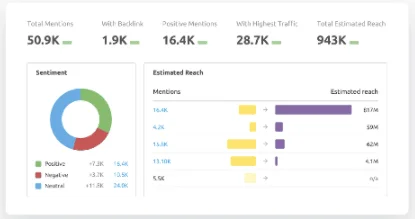
Source: https://www.semrush.com/features/brand-monitoring/
Take full advantage of technology
Thankfully, it’s become easier for content marketers to utilize available technology — like AI and machine learning — to make more data-driven content strategies.
Plus, good business leaders see the true value of investing in martech. An Adobe study on digital trends noted that top-performing businesses were twice as likely to use AI in their marketing strategies than their competitors. Even in hardcore sales (which is generally considered the antithesis to content marketing), the adoption of AI and automation technologies is predicted to increase by more than 100% as per Salesforce’s State of Sales report.
This is great news for content marketers who have long struggled to understand the data’s place in their work. New tech platforms and measuring systems make it easy to gather, organize and track metrics more accurately. What’s more — AI-enabled predictive algorithmic forecasting lets marketers precisely chart out trends and their impacts across industries in business, government and non-profit.
Correctly utilizing predictive analytics makes a content marketer’s job easier. A simple example is how marketers use Google Trends today to spot upcoming keyword trends and decide topics and themes on which to create content. Another content planning martech tool is MarketMuse, which uses AI to determine the topics that might work best for your site as well as the keywords that can generate the most traffic.
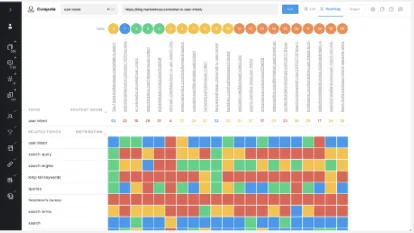
Source: https://www.marketmuse.com/
Finding balance
Although technology is becoming more common and prevalent in the content creation process, marketers need to understand its place in the overall scheme of things. Ultimately, content marketing relies on creativity and empathy, which algorithms and AI struggle to provide.
Data certainly has its place, and it can be used to support content marketing, but it must not be the end-all, be-all. As data tools become more popular to use throughout business strategies, marketers must learn how to balance their so-called human skills with technology to improve the content’s quality and results.
Customers want personalized and humanized content. So when content’s only purpose is to sell, it will likely be unsuccessful, so companies who continually dig for ROI from content marketing in terms of dollar value may be disappointed.
After all, Gary Vaynerchuck once famously asked, “What is the ROI of your mother?”
Like a relationship, content marketing is a series of conversations, and you can never assign a dollar value to each person-to-person conversation, be it parent-child or brand-customer. Consumers can sense when a piece is merely promotional and are often turned off by it. So, although an AI tool can gather hard data to “learn” about consumer segments, a content marketer is the one who actually “understands” their audience. Ultimately, it is up to content marketers to convey the value they offer without tying it directly to monetary gain.
Looking for a quick guide to relationship marketing? You’ve come to the right place. If you’ve landed here, you’re most likely hoping for a little extra info on what is relationship marketing and how it can help you start to either generate more leads or get customers coming back.
Below, you’ll find a nifty guide outlining what relationship marketing is, a few pretty awesome relationship marketing examples and some quick and easy strategies to help you get started — beginning with the basics.
What is relationship marketing?
Relationship marketing aims to build and maintain personal connections with your customers leading to more business whether through word-of-mouth promotion or effective content strategy.
Relationship marketing is a part of customer relationship management (CRM), focusing on long-term customer engagement and customer loyalty.
Individual sales and customer acquisition are simply byproducts of a successful relationship marketing strategy. Instead, focus on your customers’ interests and needs and encourage meaningful engagement. This way, you create the necessary relationships to make more sales over an extended period of time.
Additionally, relationship marketing’s ability to keep you in close contact with customers loops you in on how they use your products and services — which should influence any changes you make. Relationship marketing not only helps you measure marketing effectiveness, but it ensures you stay connected with customers, and according to Gallup, fully engaged customers will spend nearly 23% more than the average Joe Schmoe.
Relationship marketing examples
To give you some ideas on how to heat up with your relationship marketing, we’ve highlighted some pretty cool (in our humble opinion) relationship marketing examples. Be sure to pay attention to how these brands took things up a notch and avoided doing the bare minimum.
Moosejaw
Possibly our favorite example of relationship marketing comes from the outdoor apparel company Moosejaw. A customer ordered a hoodie for his girlfriend as a Christmas present, but unfortunately, she broke up with him a few weeks before the holidays. The customer returned the hoodie, asking for a refund and wrote under the reason for return, “girlfriend dumped me.”
A few weeks later, a large package from Moosejaw arrived with a smattering of t-shirts, stickers and a card that read, “We’re sorry your girlfriend broke up with you, we decided to give you a gift.” We can’t imagine a more personalized response in customer service.
Lay’s
Lay’s is a great example of a company that builds customers’ trust in their brand through interactive content. Lay’s annual “Do Us A Flavor” contest asks customers to submit their ideas for new chip flavors. Once the submission window has closed, participants then vote on flavors through social media, with the winning flavor added to Lay’s flavor lineup Oh, and the customer who suggested the winning flavor gets a hefty cash prize.
GE
One strategy for relationship marketing is through content, and GE’s use of content marketing is pretty solid. By conducting extensive research into their customers and what they need — even down to the socioeconomic contexts — GE is able to personalize its content based on specific audiences. For GE, relationship marketing isn’t focused on individual transactions but rather the relationships with customers in each market, therefore setting the stage for valuable marketing investment, especially in countries with lower revenue potential.
BetterCloud
Customer service in itself makes up a huge part of relationship marketing and BetterCloud hits it out of the ballpark with its “proactive support” system flags. By collecting data on how customers use BetterCloud software, along with any errors or struggles they encounter, BetterCloud is able to proactively reach out to affected customers long before a support ticket is submitted.
Zappos
Zappos makes it clear how customers can contact the brand by placing the customer service phone number front and center on their website. When customers call with concerns, representatives do more than simply take care of the problem — they ensure customers feel heard. For instance, one rep has sent baby blankets to parents who had crying children in the background. Another sent flowers to a customer after she tried to return boots bought for her father who passed away before he could wear them. For Zappos, relationship marketing is about reading between the lines and actively listening.
Benefits of customer relationship marketing
Now, these examples are all well and good, but is relationship marketing really worth the time and effort?
Boost in customer retention
Customers who feel that their needs are being met and that they’re also being heard tend to stick around. Going past the basics to keep your customers happy is only ever going to be a lucrative investment.
Increased customer life-time-value
By building a relationship with your customers, you’ll increase not only customer retention rates but also the lifetime value of your customers. Lifetime value measures a customer’s total sales, as well as their loyalty and advocacy of your brand — e.g., customers become brand advocates or ambassadors (influencers) who recommend your products or services to friends, family members or even work colleagues.
Collect and apply feedback
As you collect customer feedback, you wind up creating a data bank to improve your customer marketing in the future. For example, feedback can be incorporated into content marketing to further nurture customer relationships.
Create customer evangelists
Customer evangelists are those customers everyone wants. They regularly purchase from you — recommend your services to friends, family, coworkers, random strangers on the street, offer praise without any financial incentive and so much more. These customers end up being one of your best marketing tools.
Elevated brand trust
If a customer believes in you and trusts you, they’re more likely to forgive mistakes and still stick around. Building a successful relationship marketing campaign to get to this point though is more than just a rewards program, it’s doing that and more.
Types of customer relationship marketing strategies
Achieving effective relationship marketing is pretty simple. In fact, you may already be implementing some of these ideas below. However, we want to highlight how you can utilize these strategies for relationship marketing specifically.
Content marketing
Content marketing generates three times as many leads as paid searches. When used correctly and efficiently, content marketing connects an audience with your brand on an emotional level and equips customers with helpful information, providing value to you and your customer. And by offering useful content regularly, your customers develop a natural interest in your brand.
Customer service
For a moment, forget that you’re the reader — remember a time when you’ve been the customer and needed to contact customer service due to a pressing issue? How important to you was it to get a quick response?
Responding quickly to your customers’ complaints, feedback or questions will show you not only care but that your brand is reliable. Advancements in AI make this a lot easier for businesses with resources like Facebook Messenger bot or ManyChat. Using a pre-programmed chat gives your customers the option of a quick and easy answer (like an FAQ) or to steer them towards the right representative. Add in the aspect of human follow up and you really raise the bar. Customer service is also a great place to generate feedback from customers to aid in content personalization.
Social media
Social media is a treasure trove for customer feedback. Nearly 95% of online adults follow a brand on social media, which can make sifting through customer comments feel daunting, but you surely want to find those golden nuggets! Remember, don’t just use social media as your personal pirate chest. Make sure you’re interacting with customers on social media too. Even something as simple as a “like” or quick response can remind folks that there are real people behind your logo.
Social media is also another opportunity for you to create effective content that strengthens customer relations. For example, if you’re in the B2B sector, keep things professional by focusing on your expertise. Or, if your audience falls within the Millennial age group, you may find using humor goes a long way on just about anything.
Email marketing
Despite what you may hear, email is still an important marketing strategy and shouldn’t be discounted. Emails tend to get more “me-time.” So, while social media can be used to share more “random” pieces of content, emails ideally feature the type of content you want your customers to really notice and focus on (e.g., you launch a new product feature or so forth). Think of emails like the big, creamy Cadbury eggs in a basket full of Easter treats — they’re all yummy to eat, but those eggs are truly satisfying.
Loyalty program
To round out our relationship marketing strategies, let’s talk about loyalty programs. A loyalty program is a real cherry-on-top kind of tactic that \supplements any marketing strategy you currently have in place. It’s a simple way to show customers that you appreciate their business and that you’d love to see them return. A successful customer loyalty program can heighten customer engagement by providing real value. Be sure to outline to your customers how your program works and the benefits included, whether it’s rewarding customers for referrals or racking up points with each purchase made. Offer discounts for feedback and you can even let your rewards programs guide better effective content.
Now that you have an idea of what relationship marketing is, it’s time to establish your own marketing strategy. Know that regardless of which strategy you choose to implement, it’s important to use effective content to draw in your customers and get them coming back for more. But don’t stress if you’re still struggling getting them to engage with your brand, check out our effective content ebook for some great ways to boost your content game.
